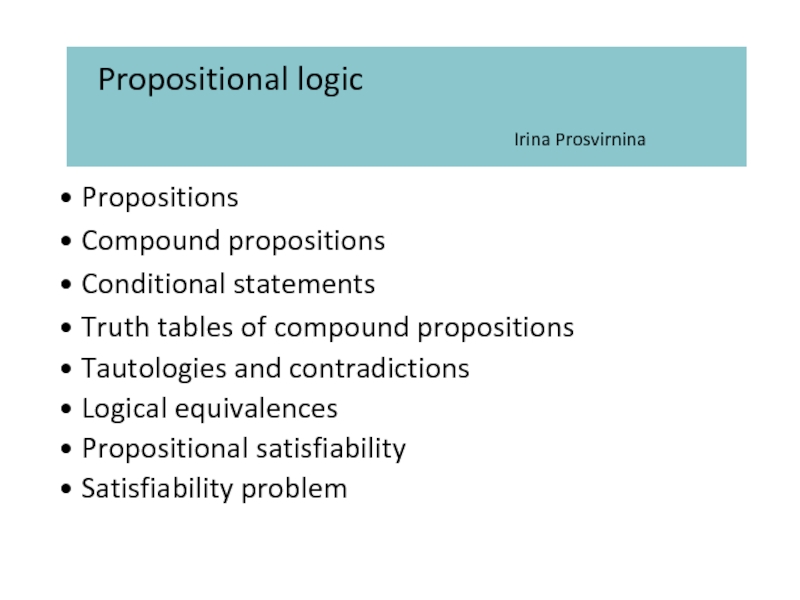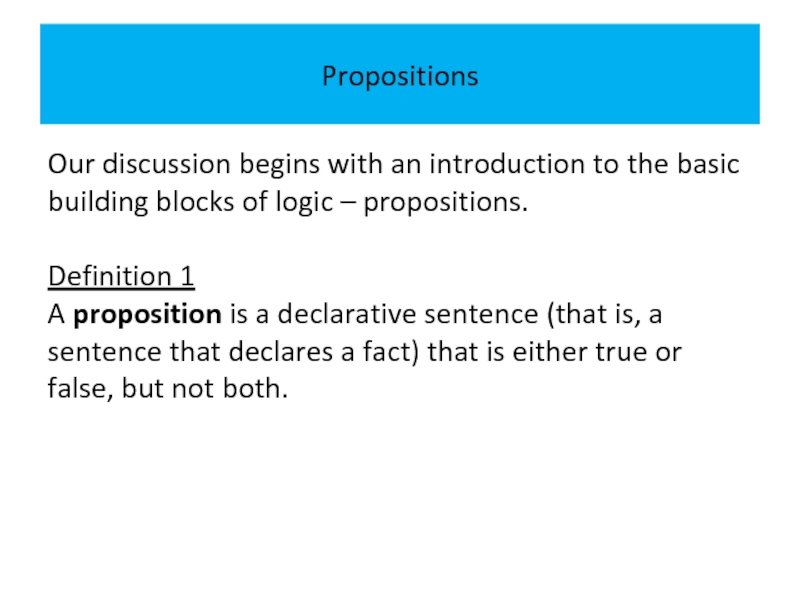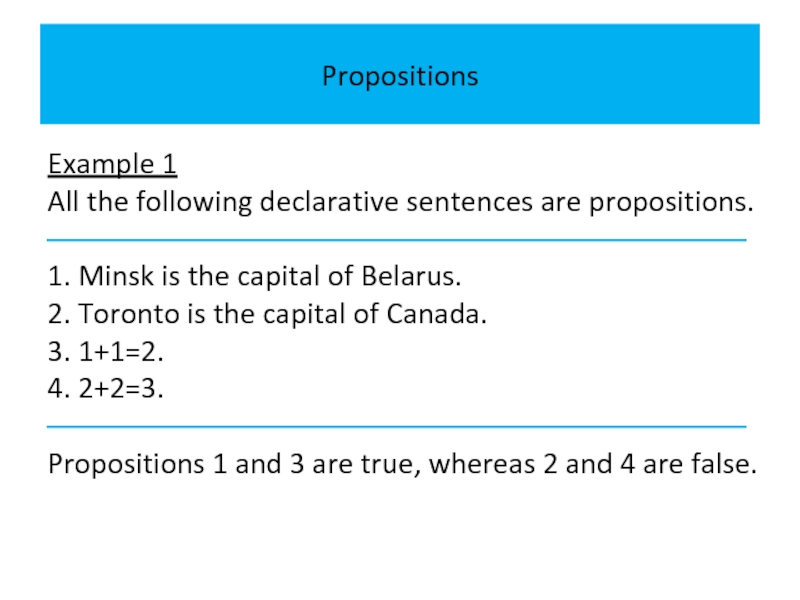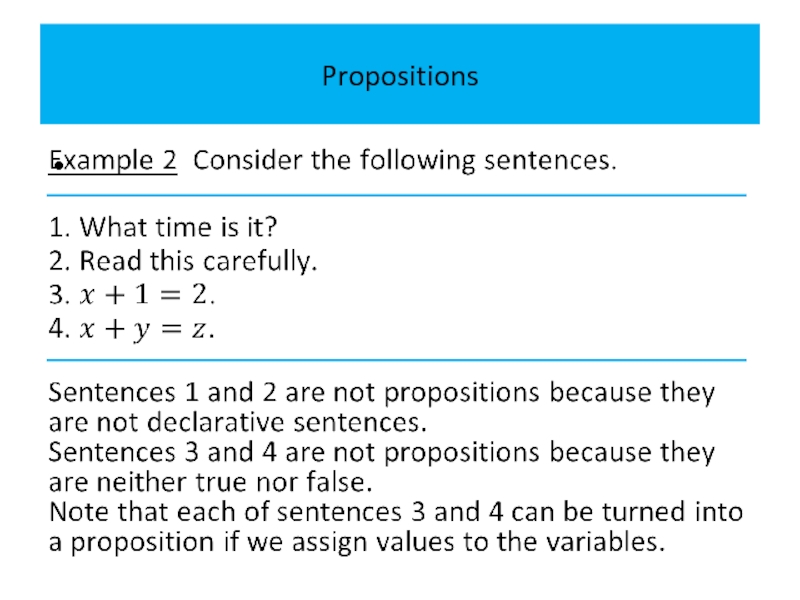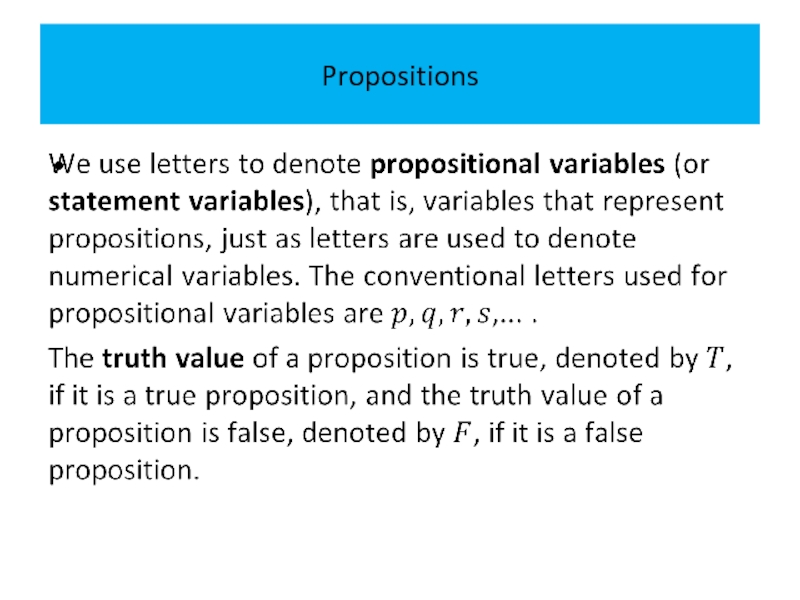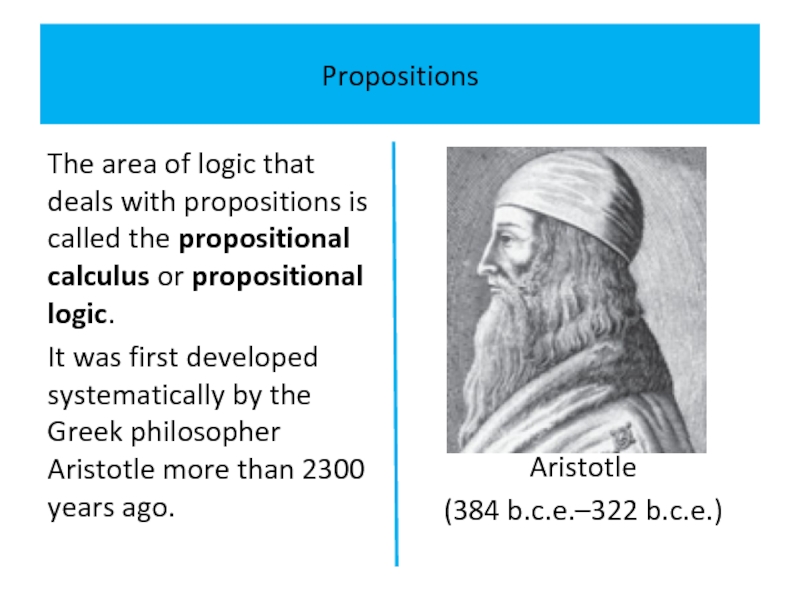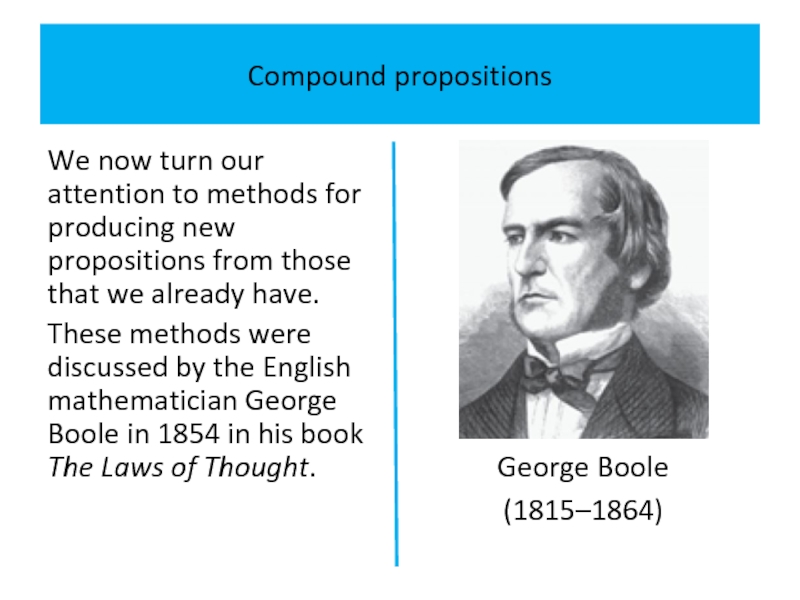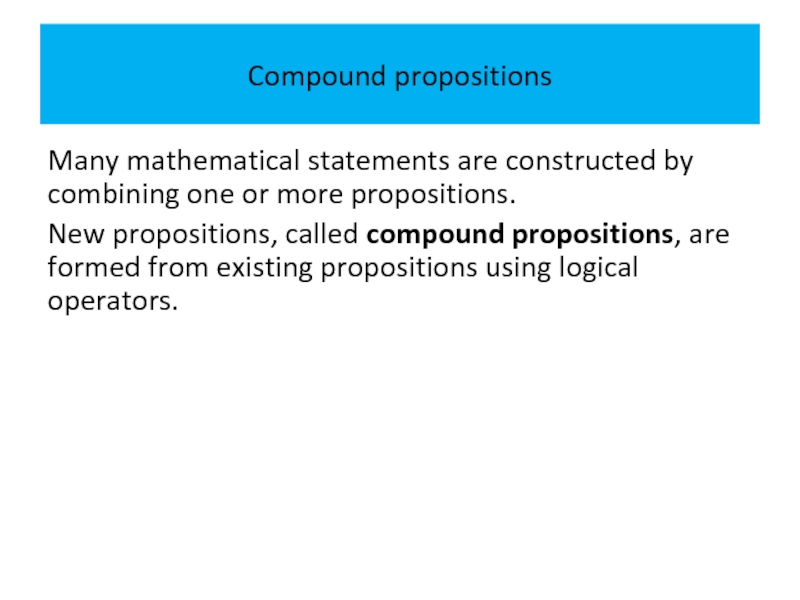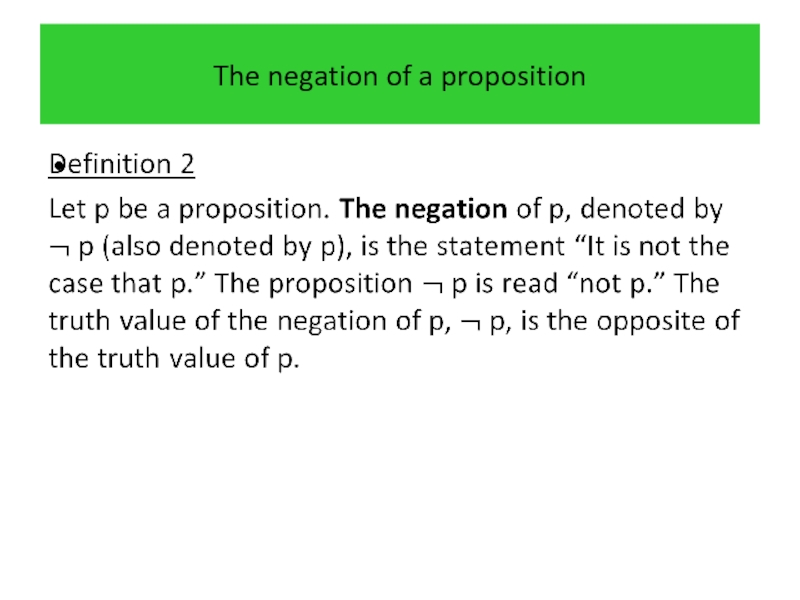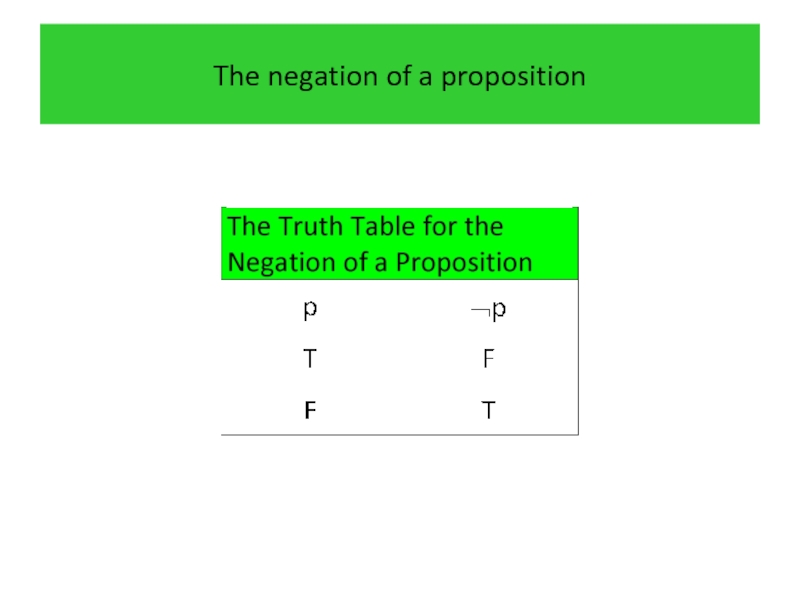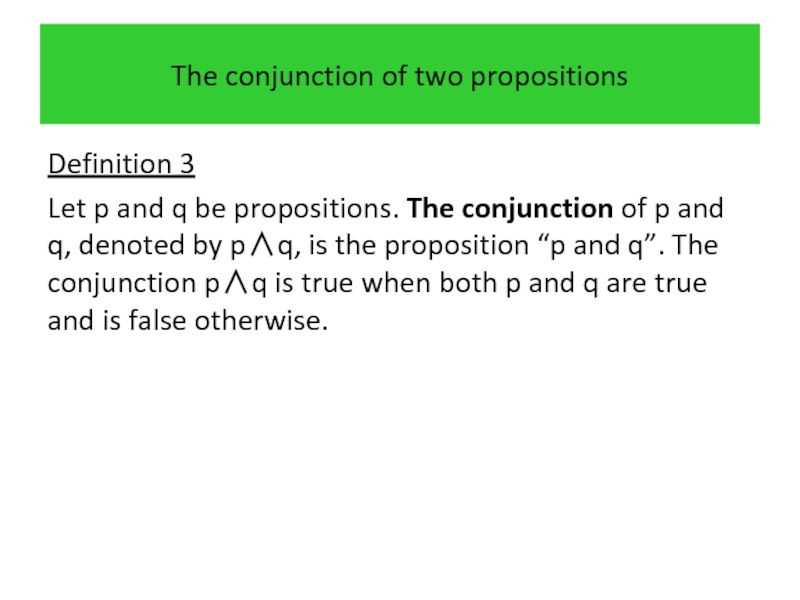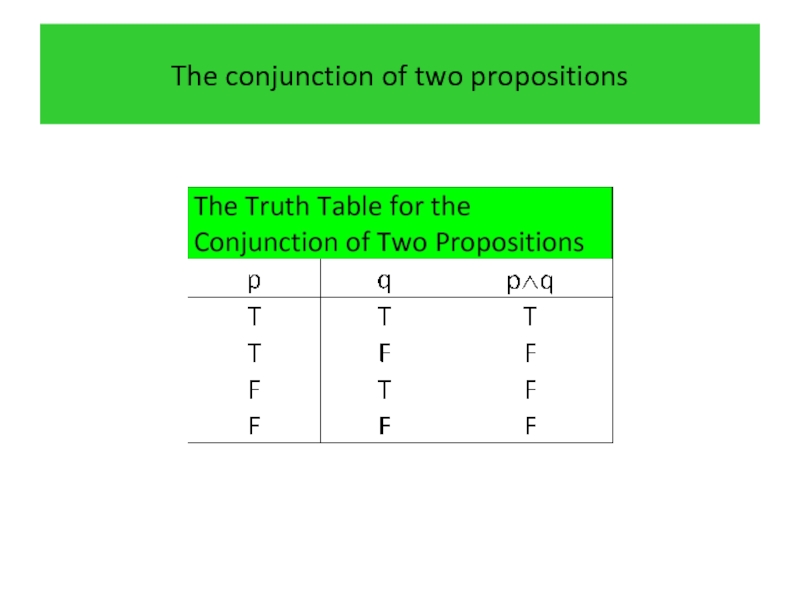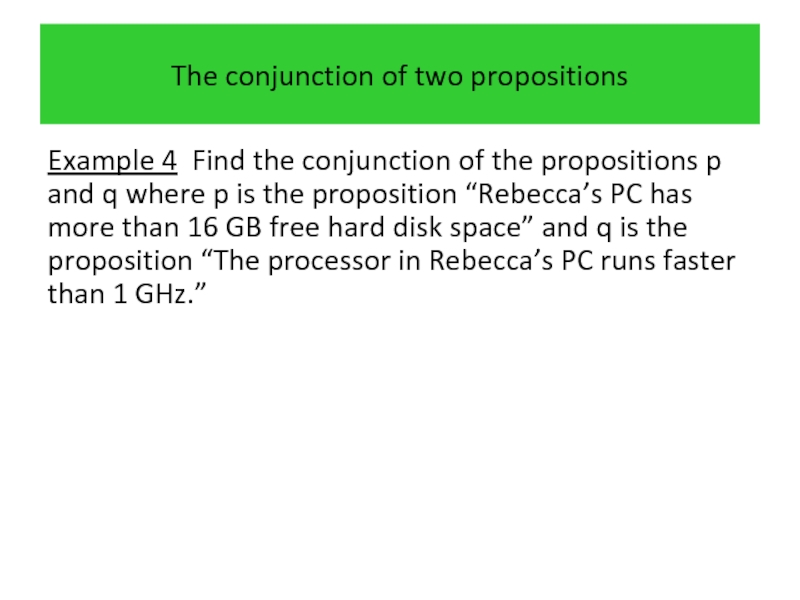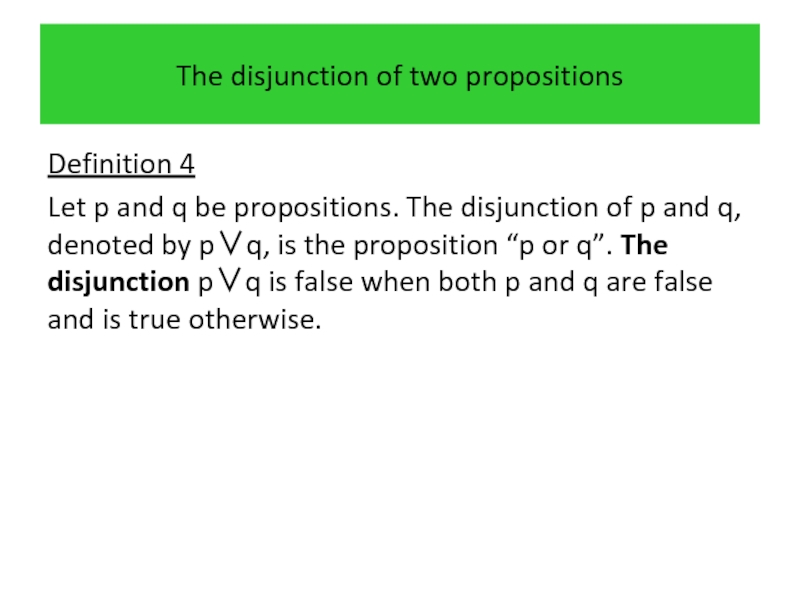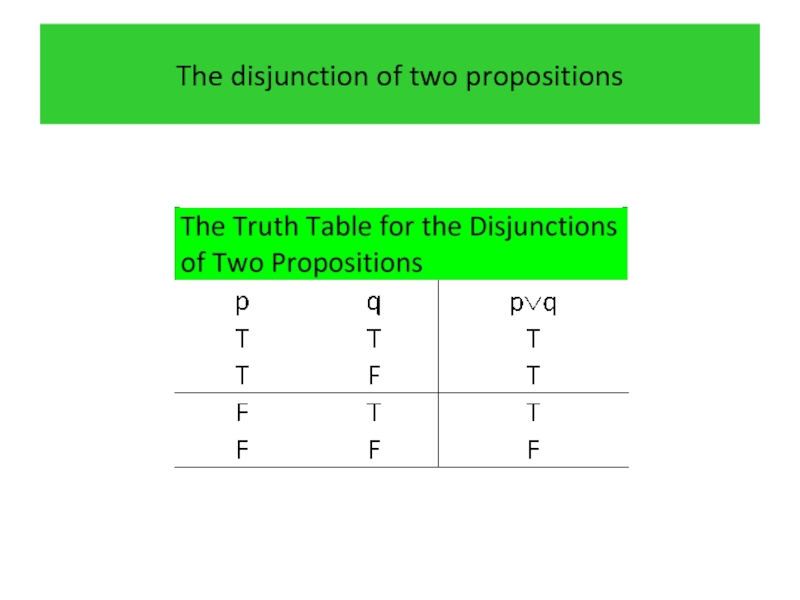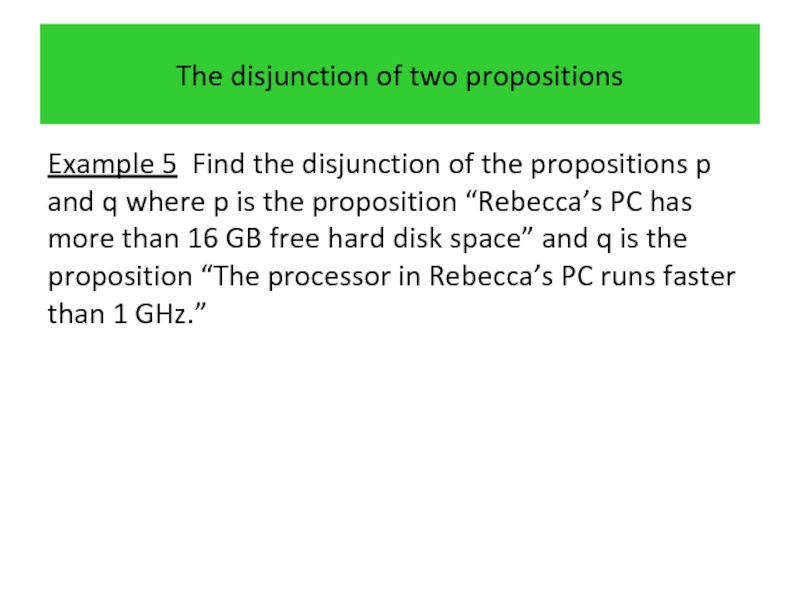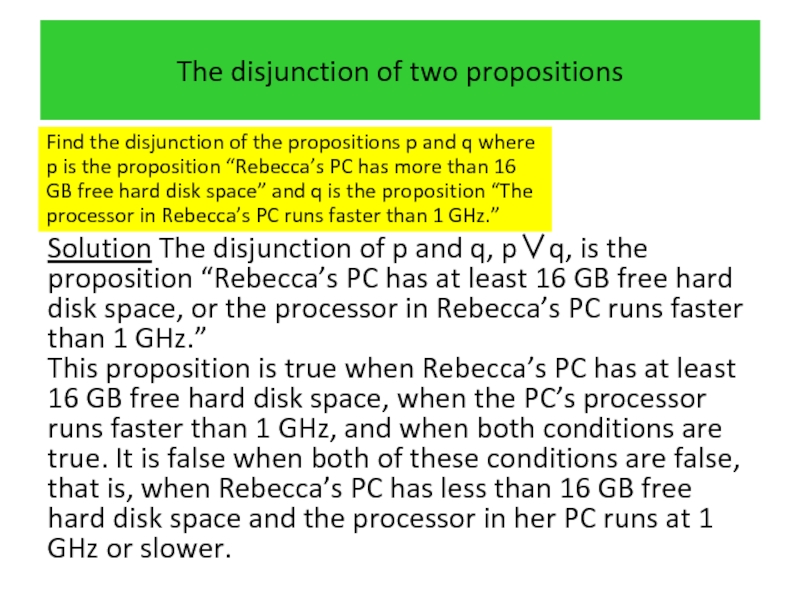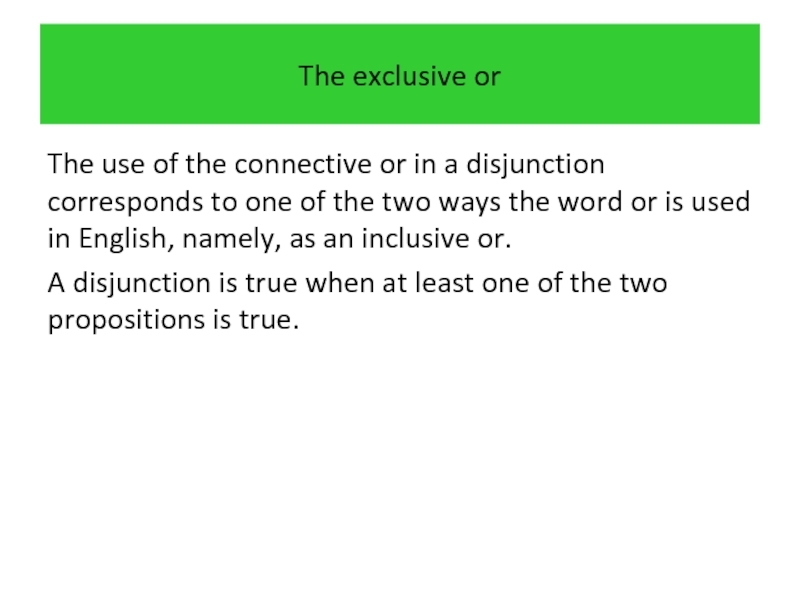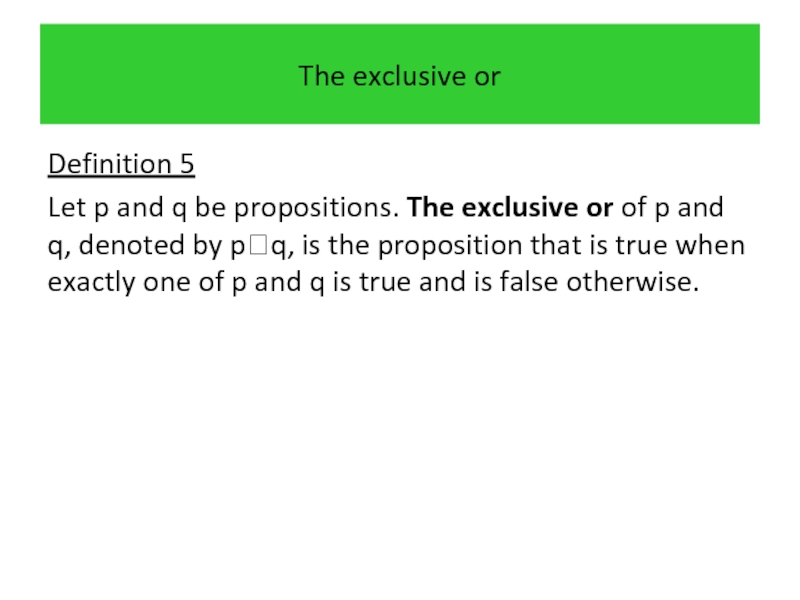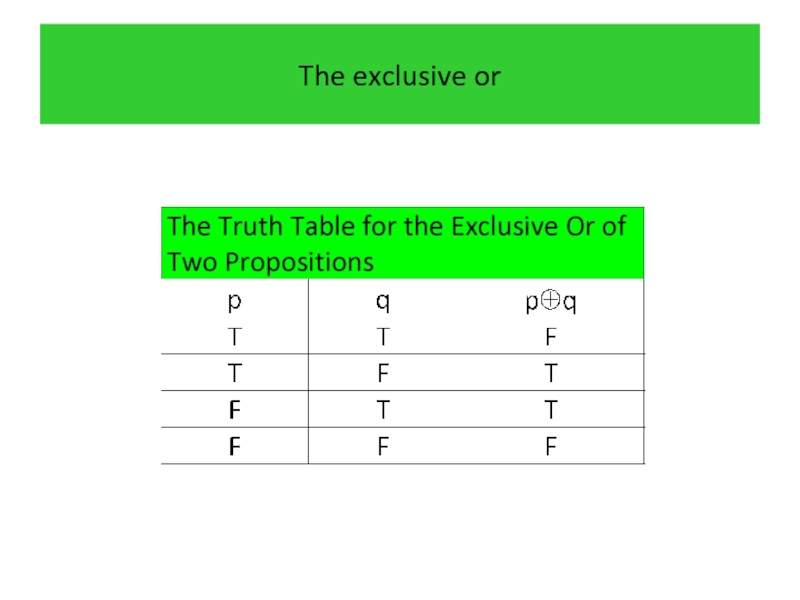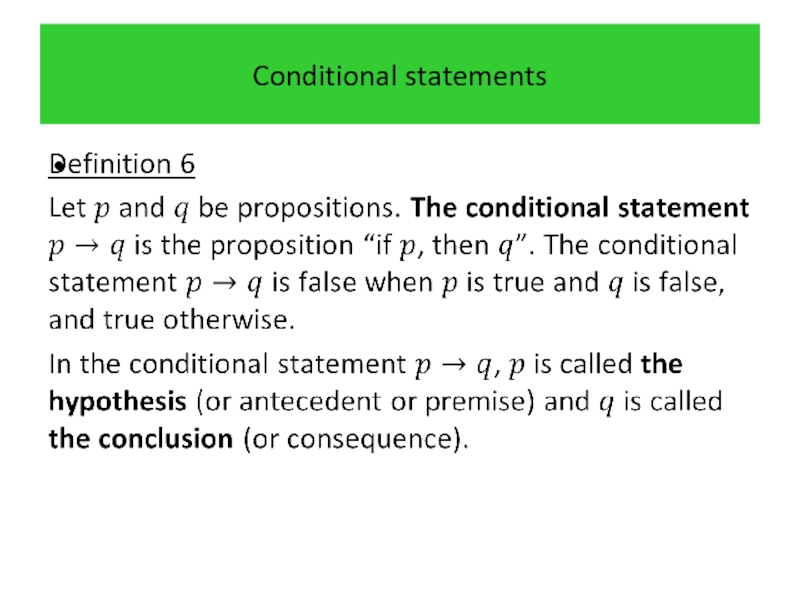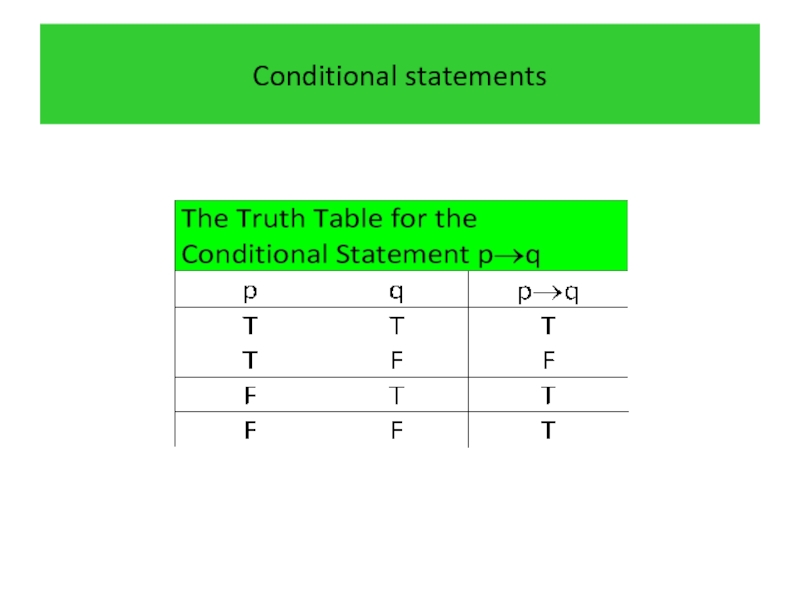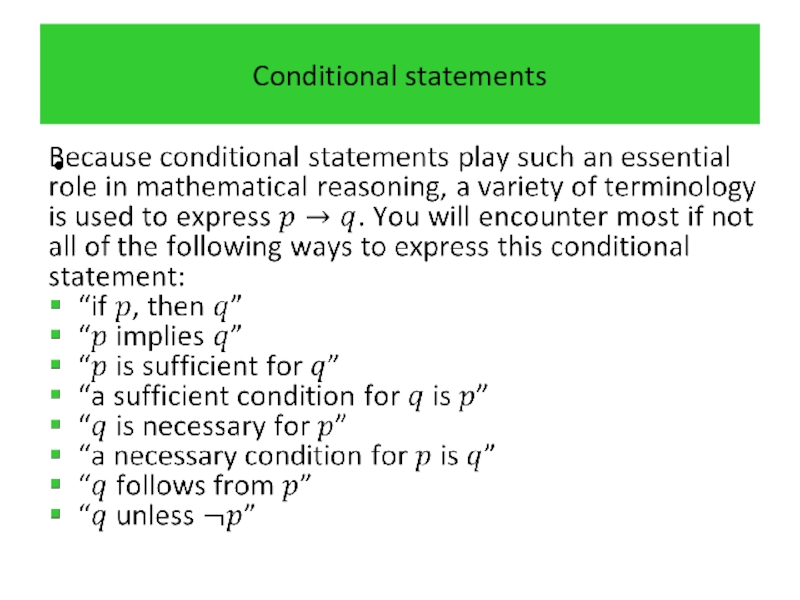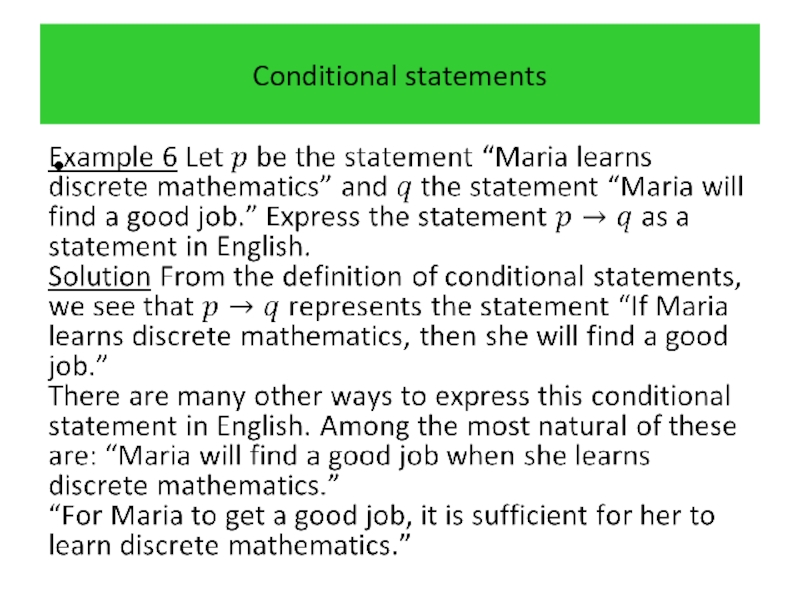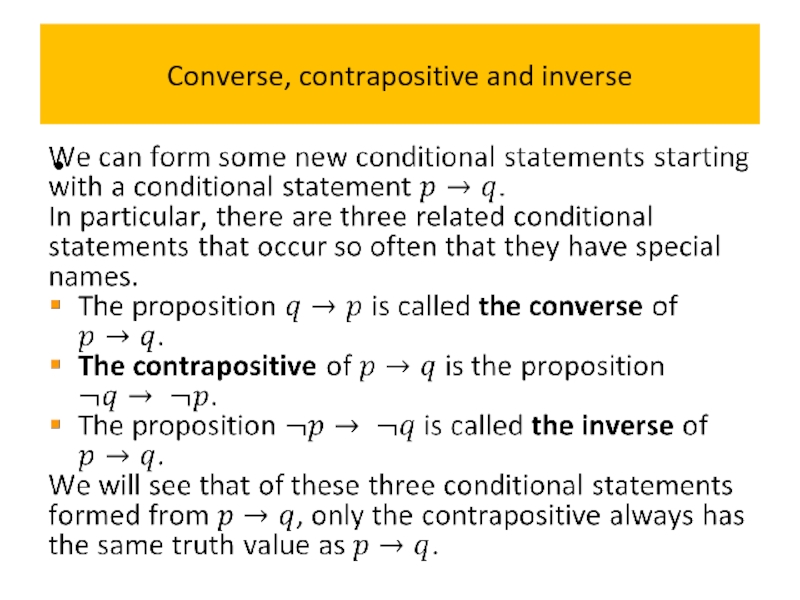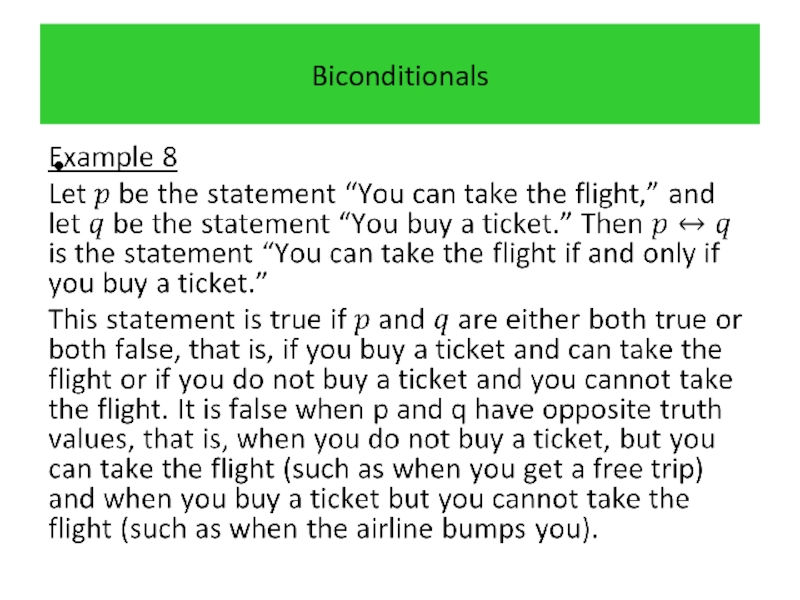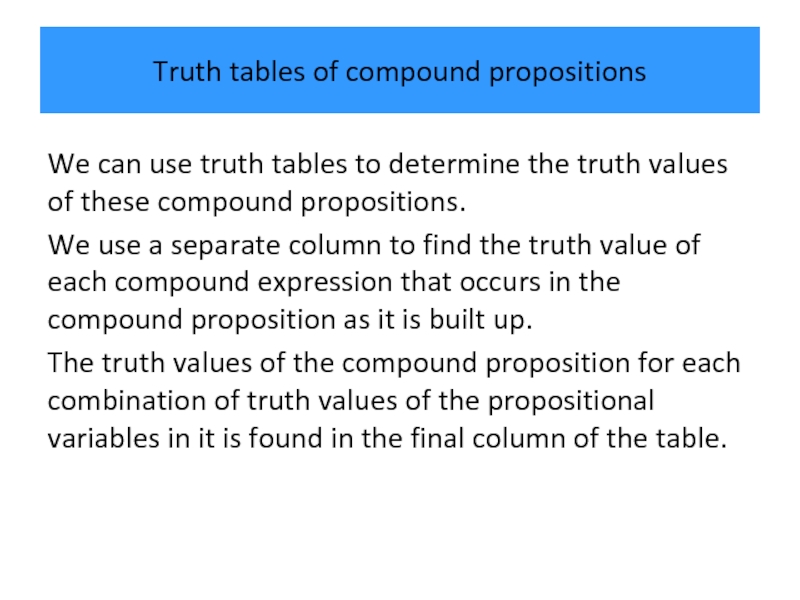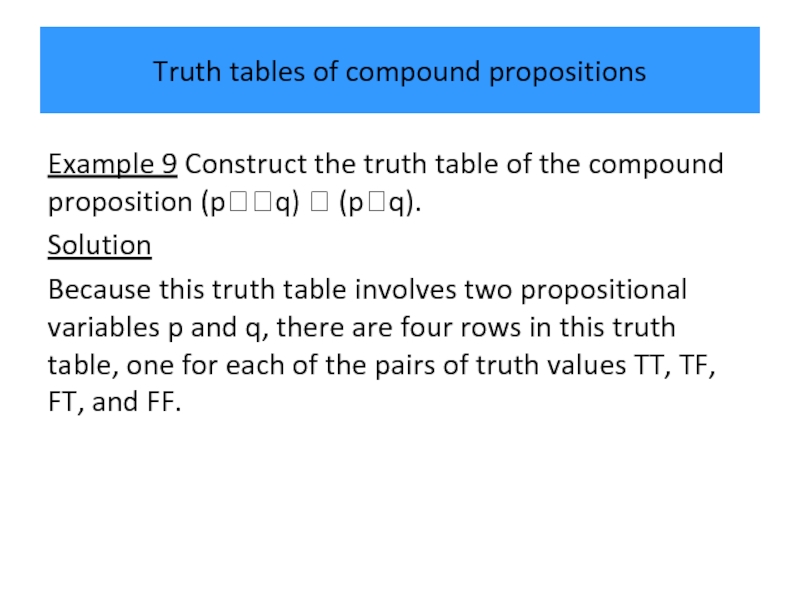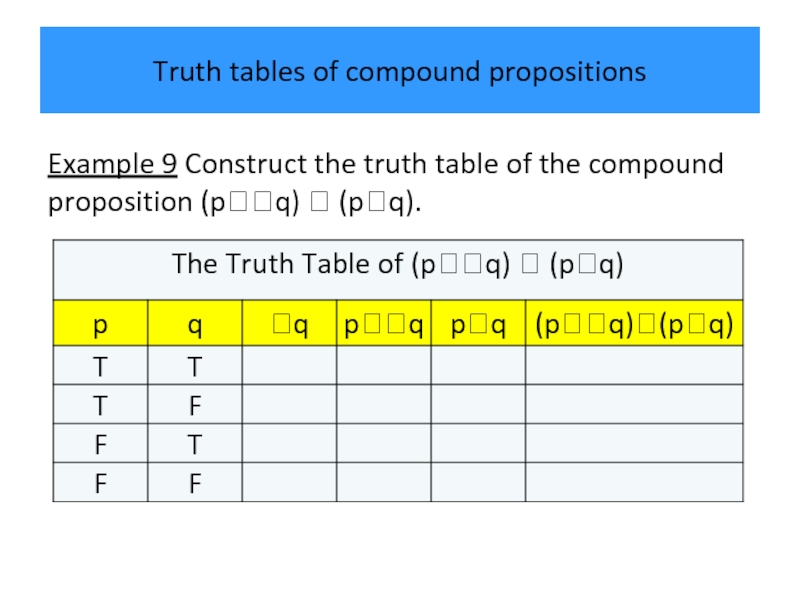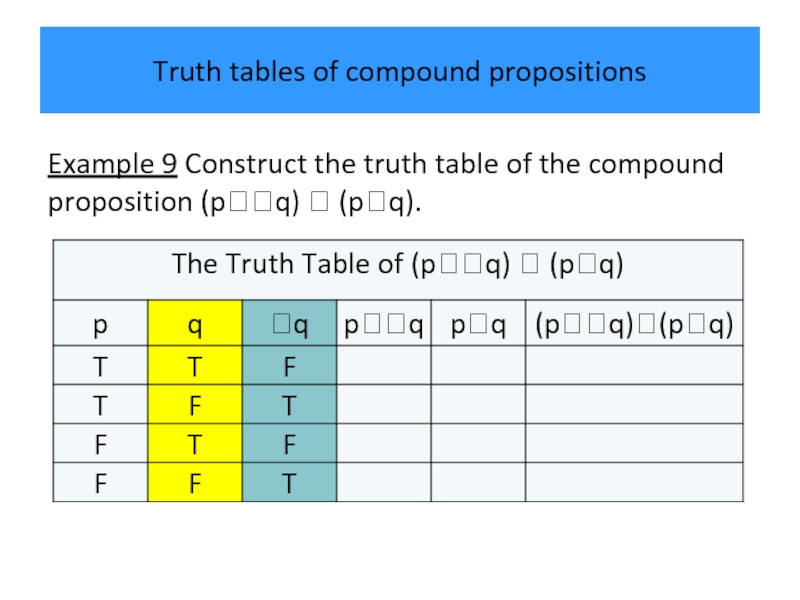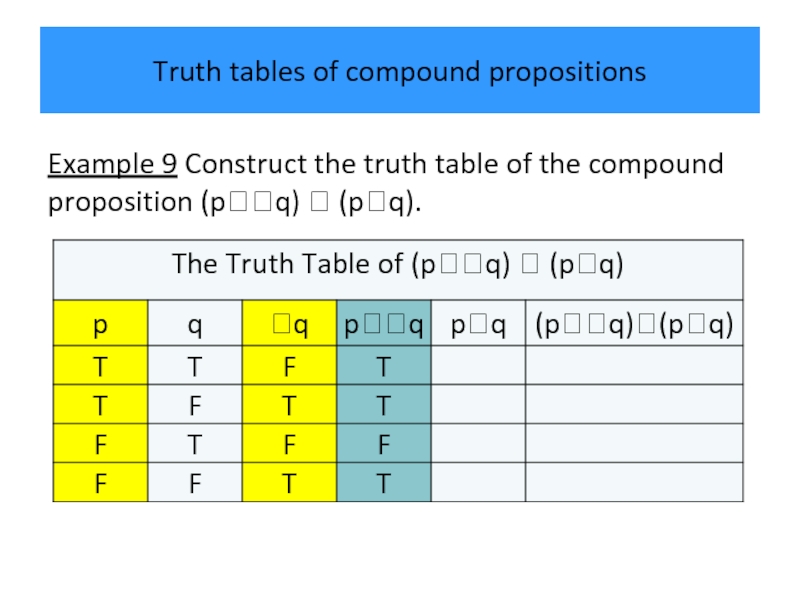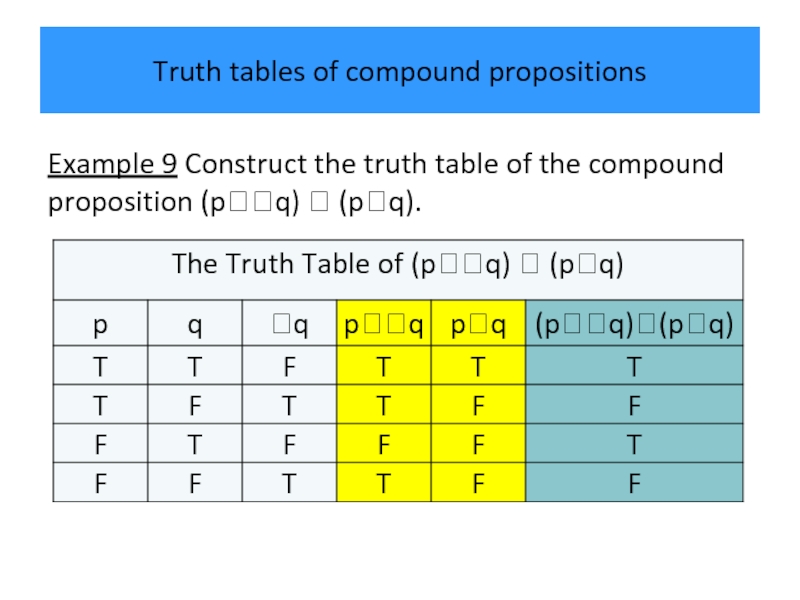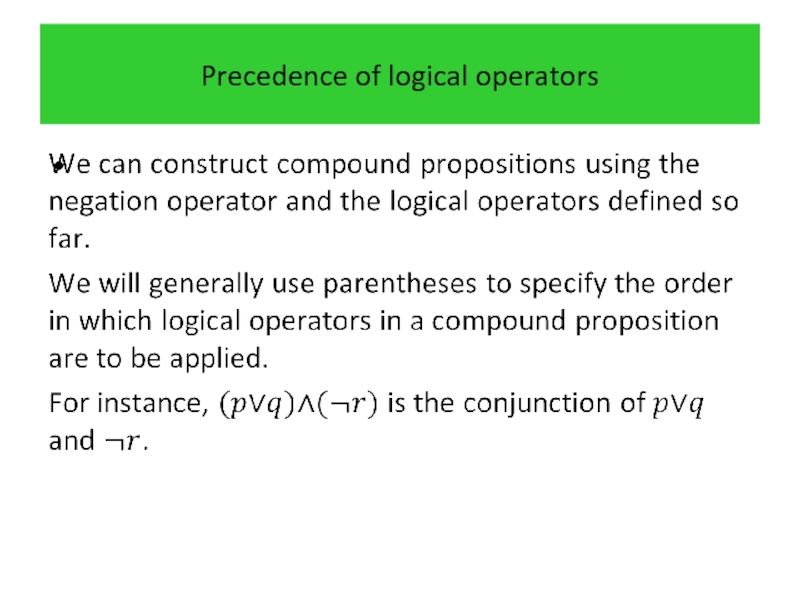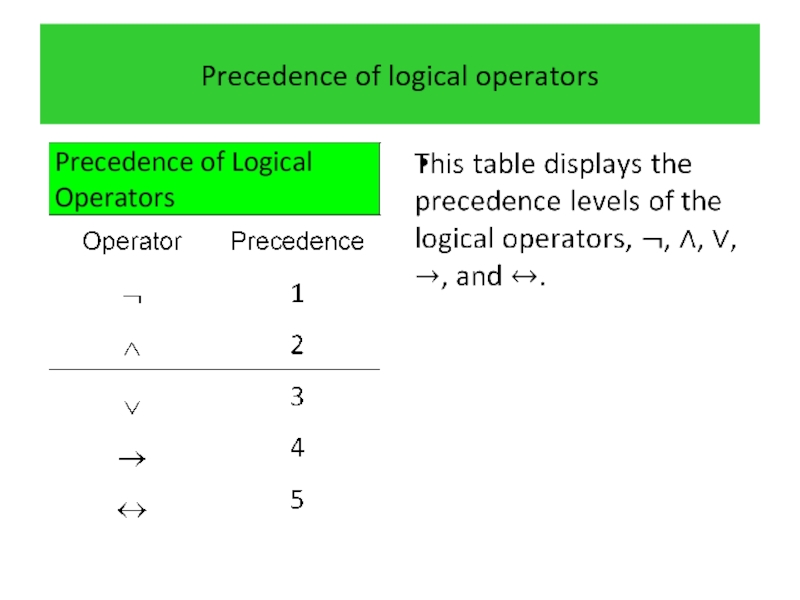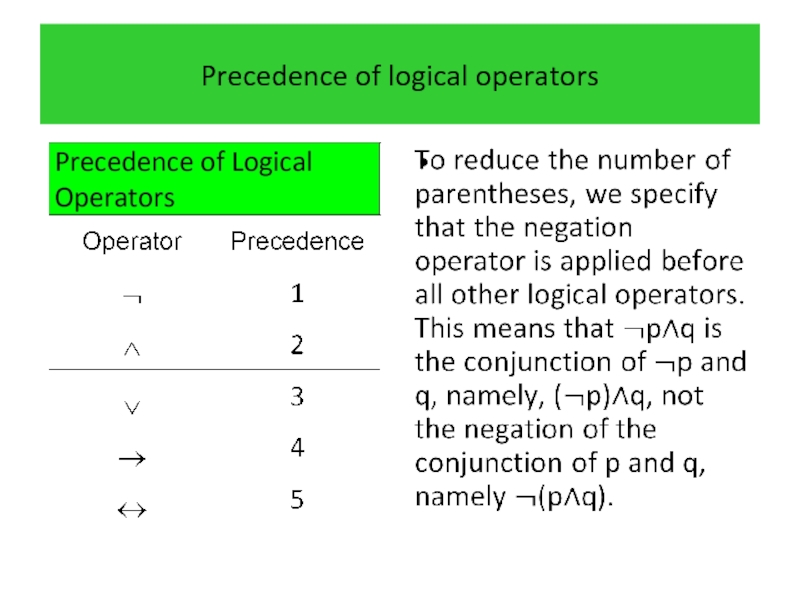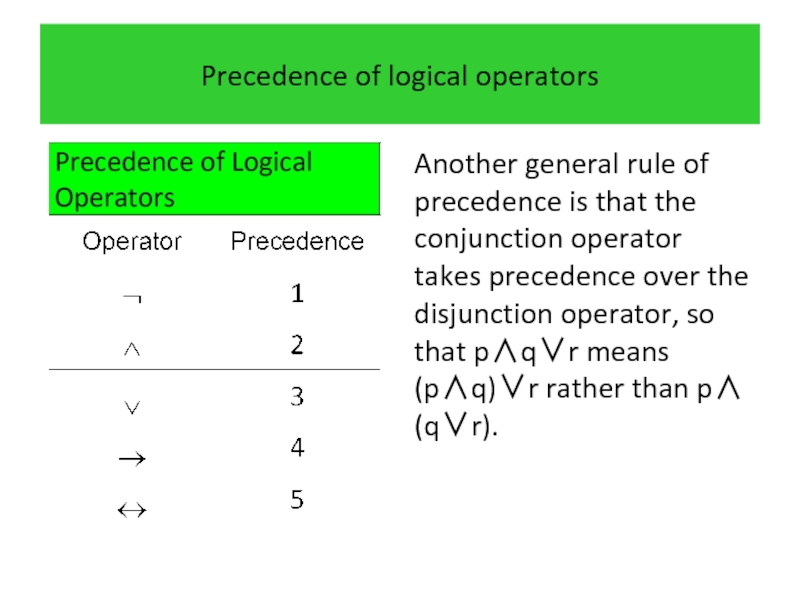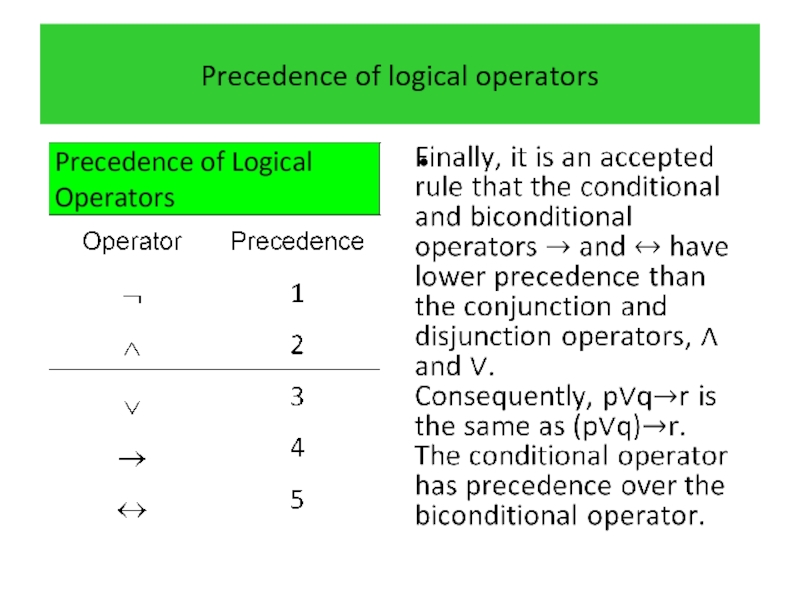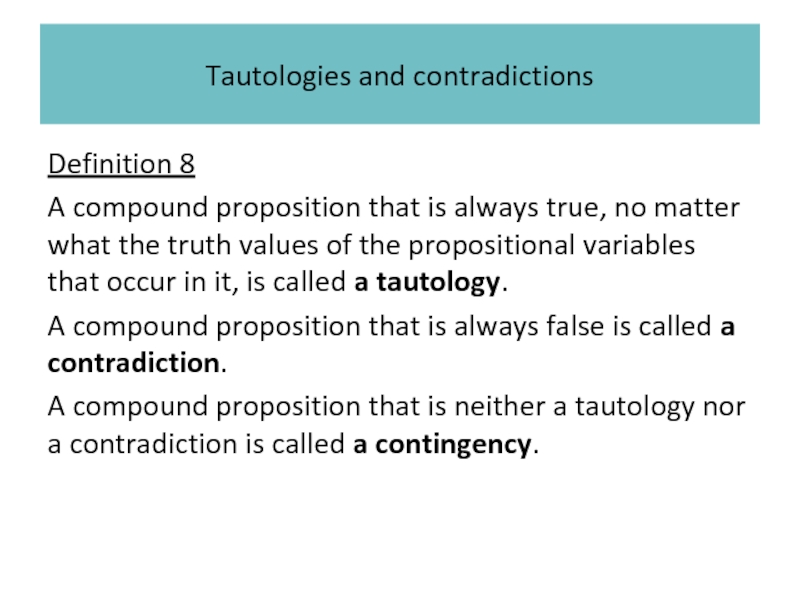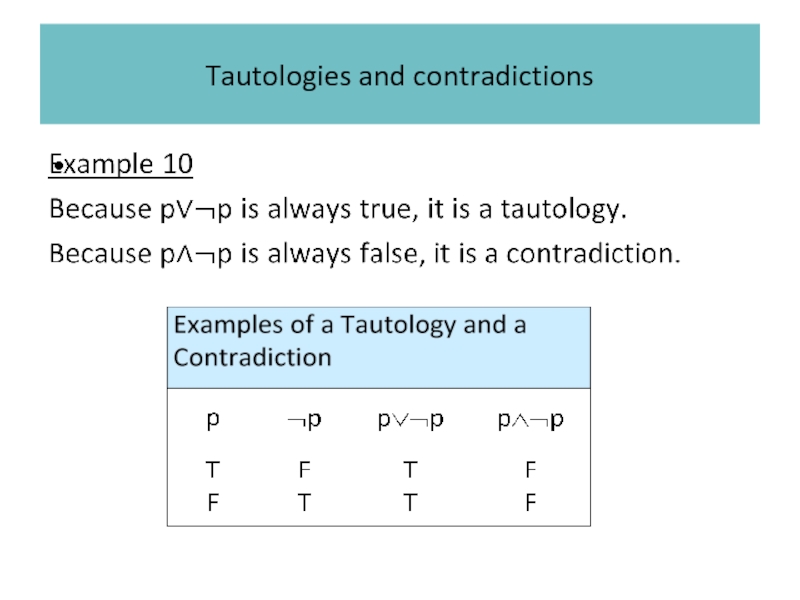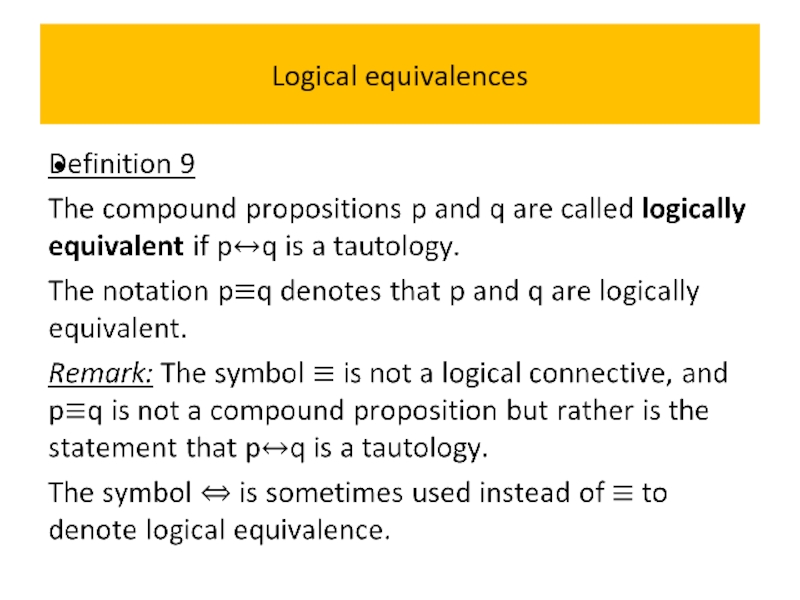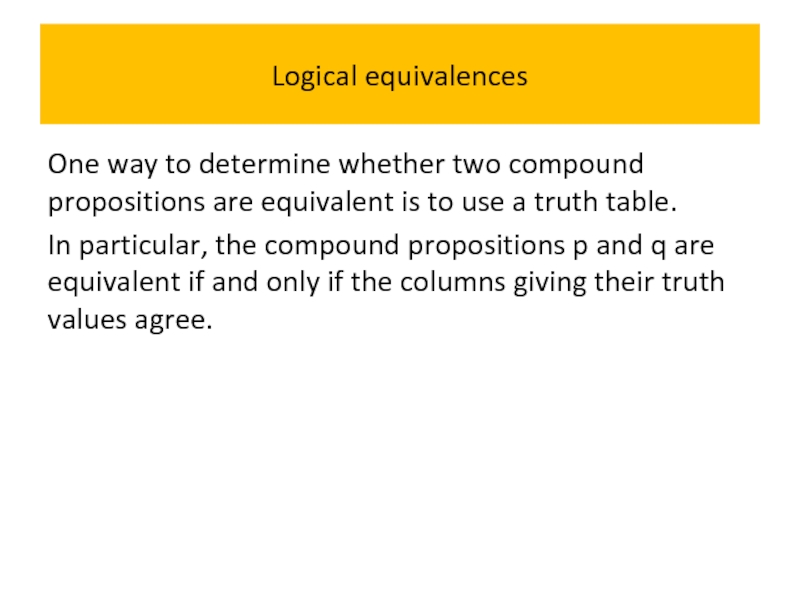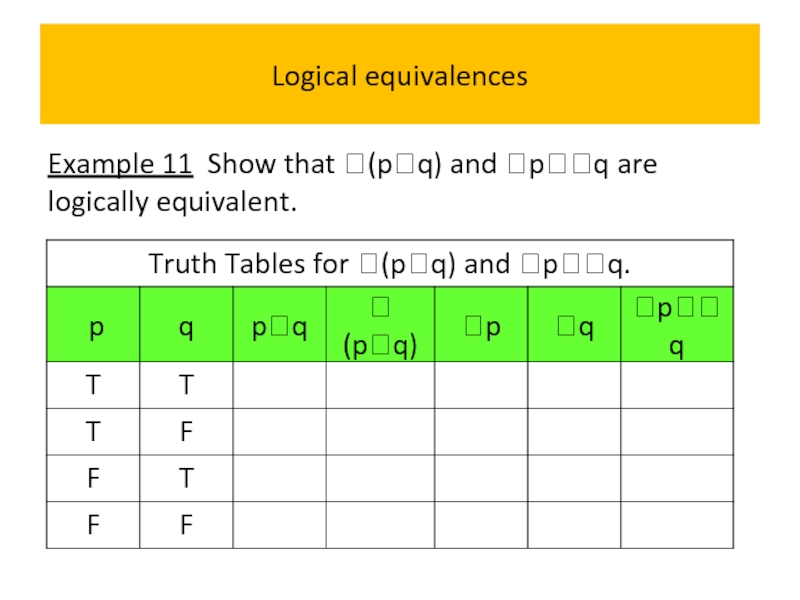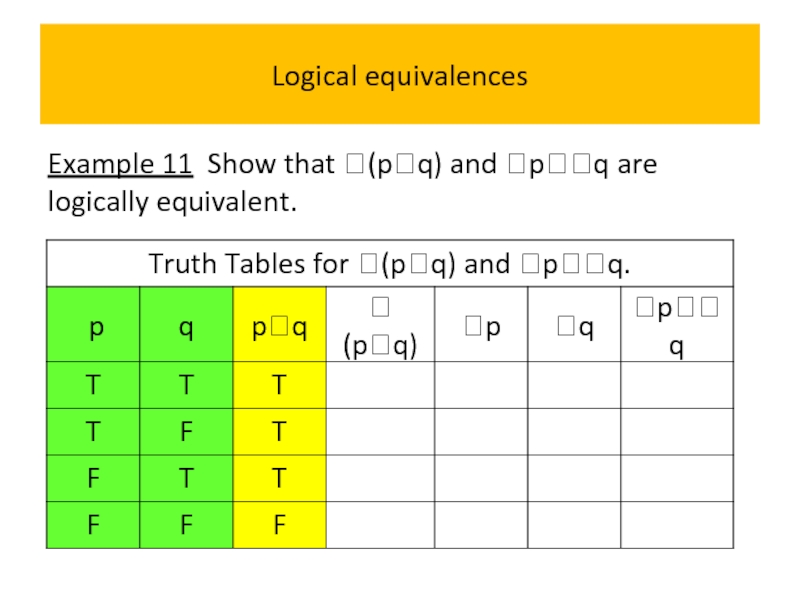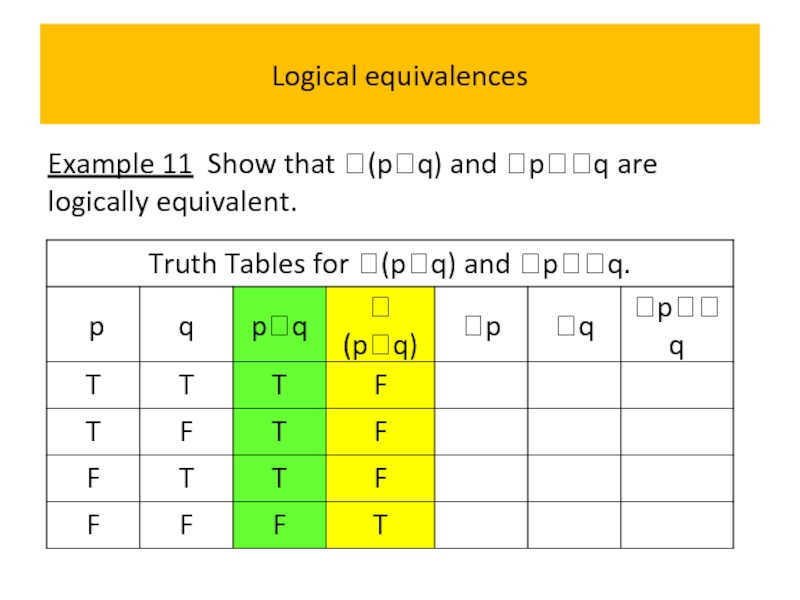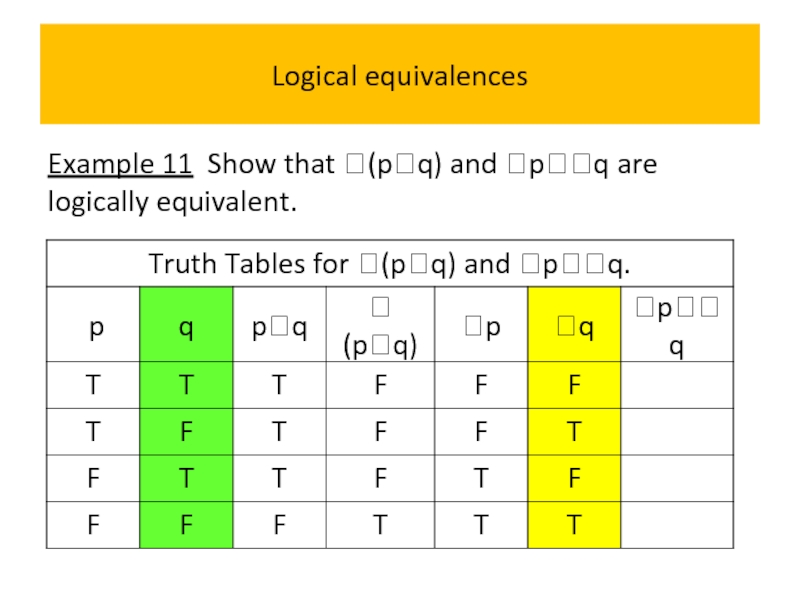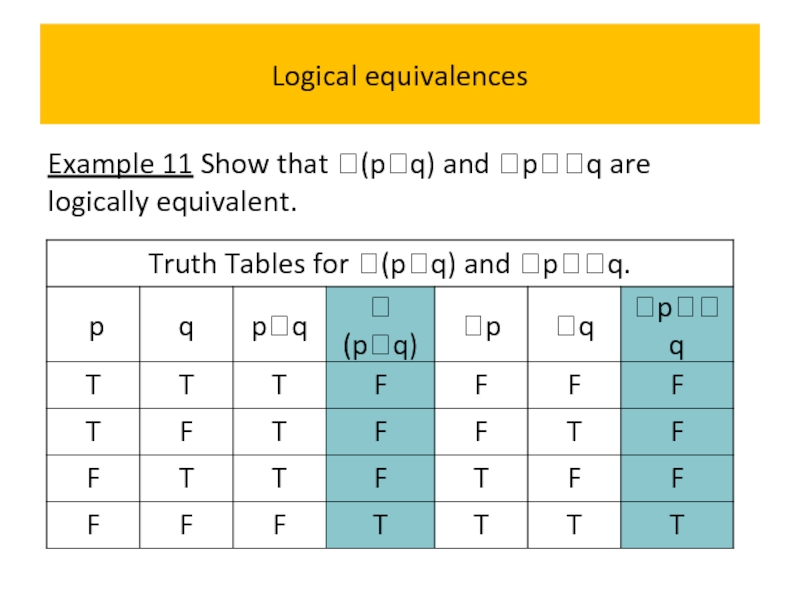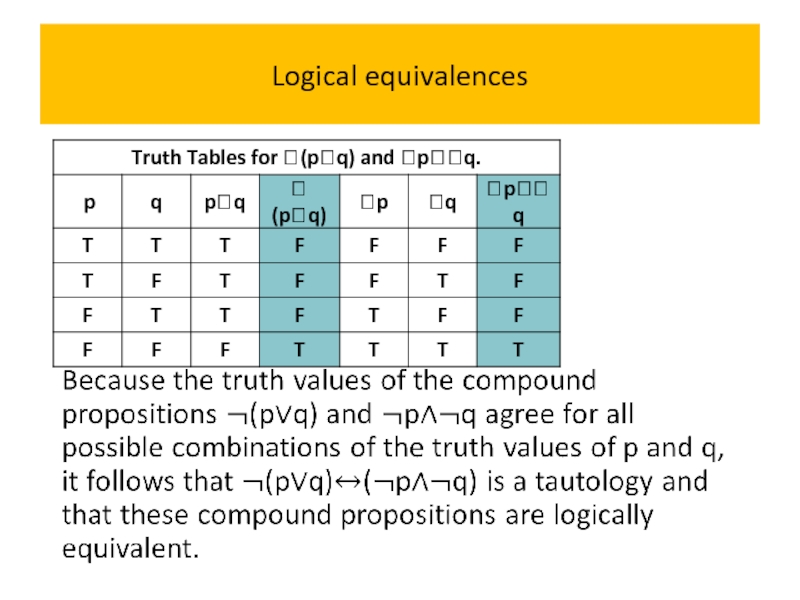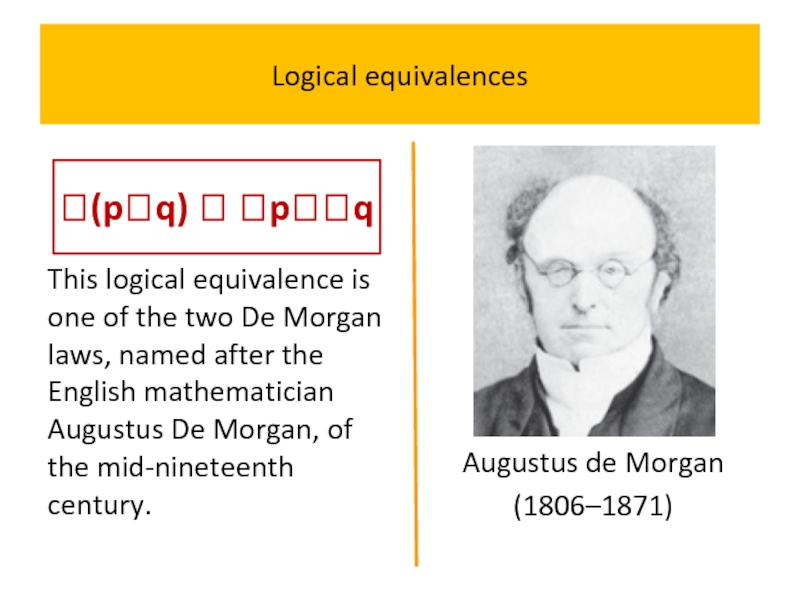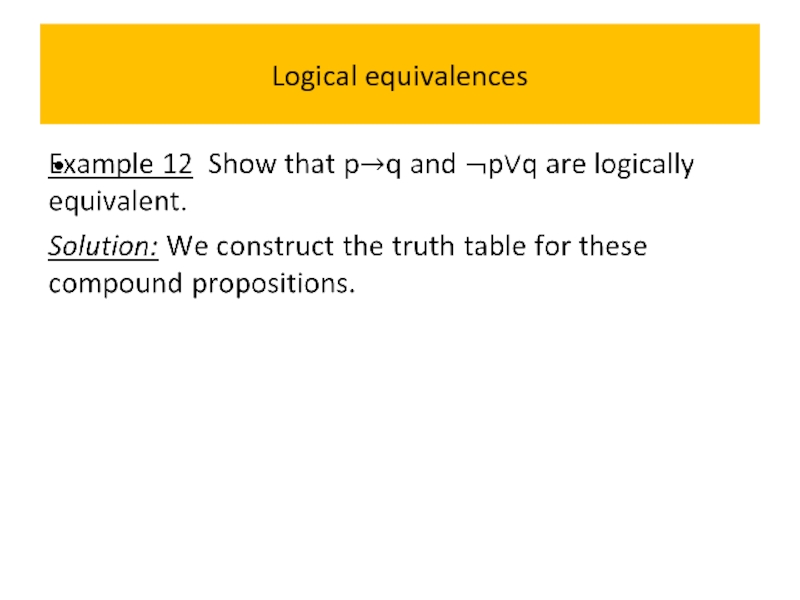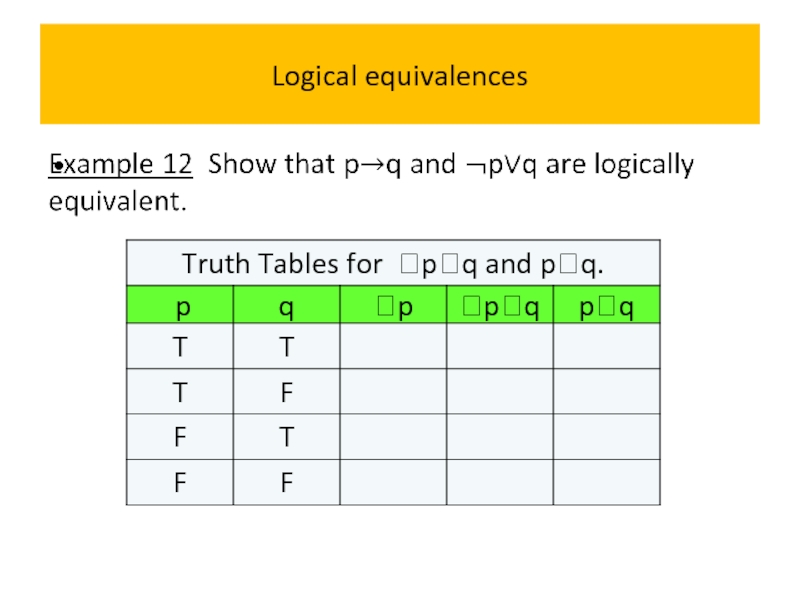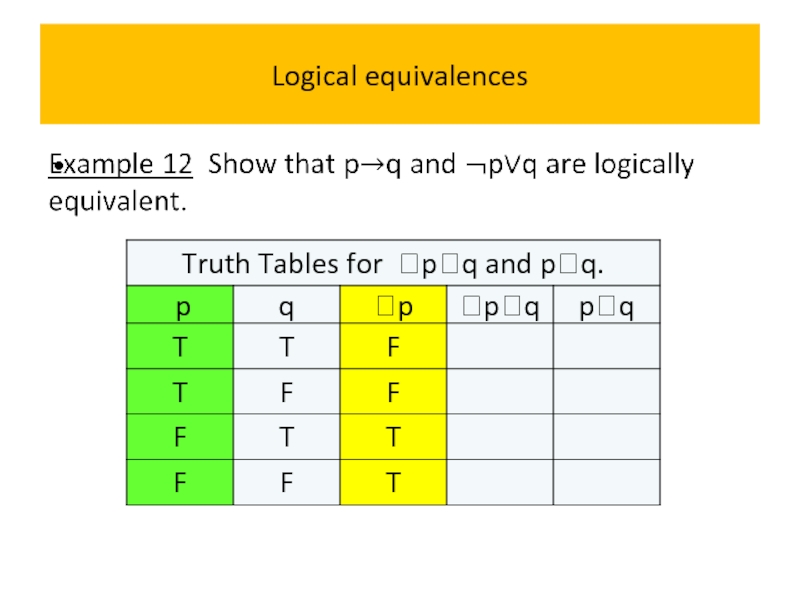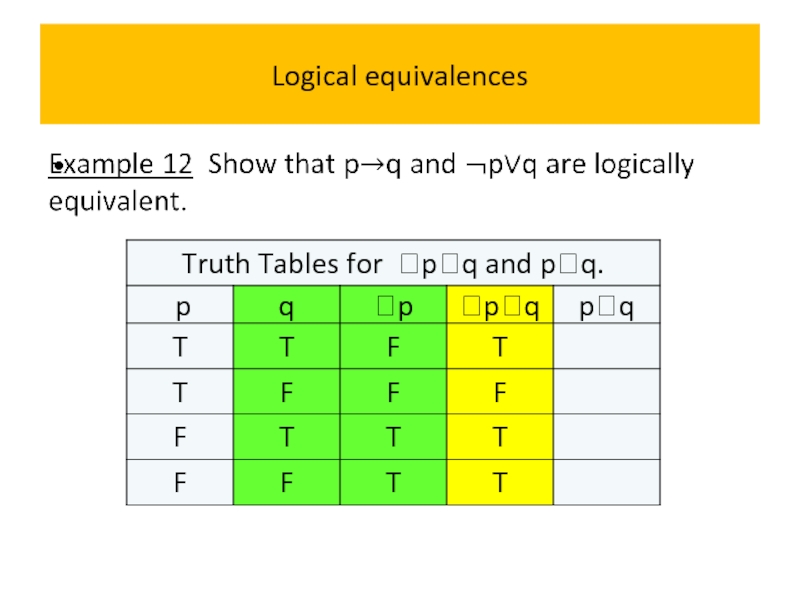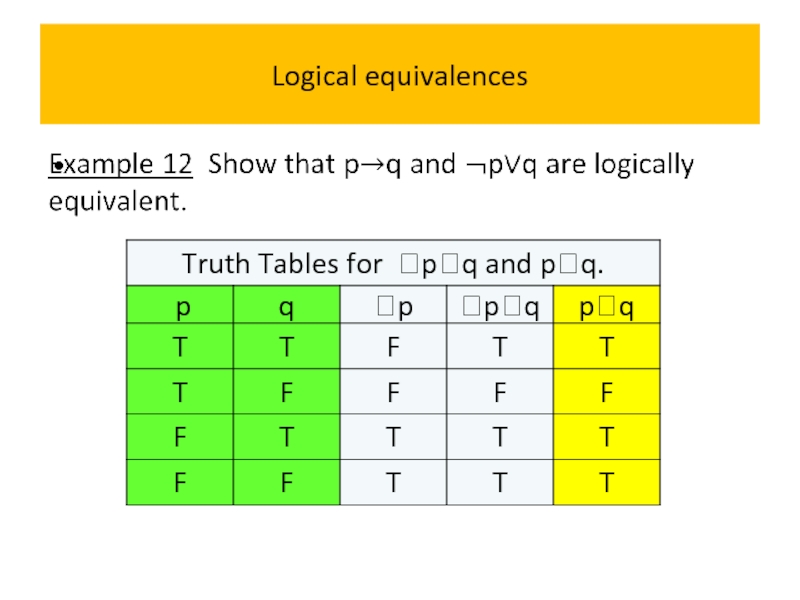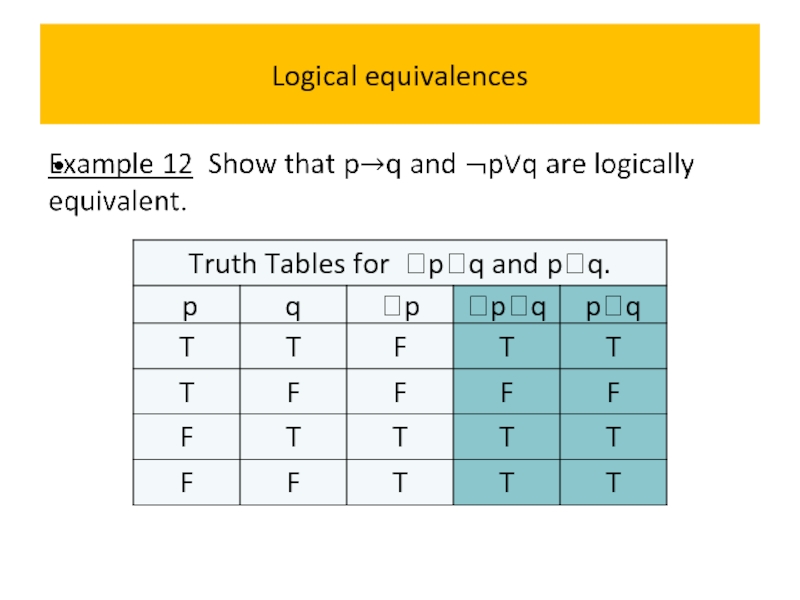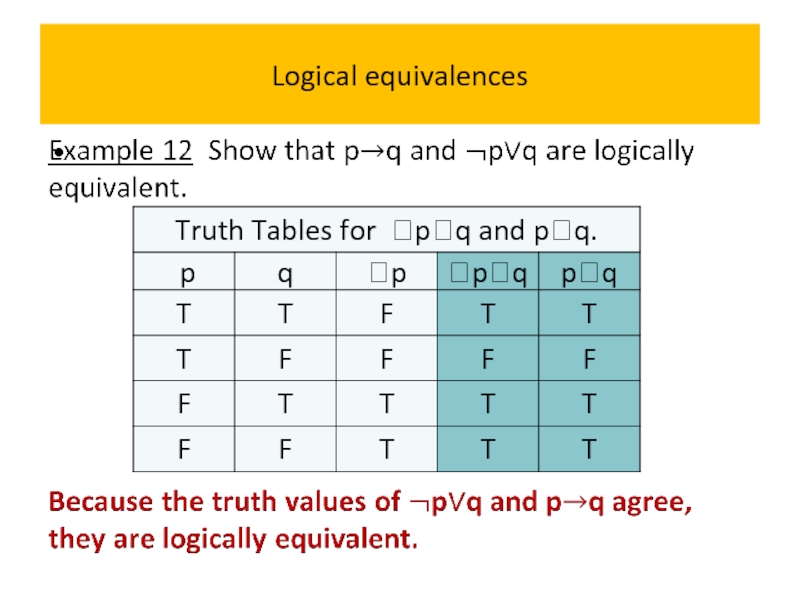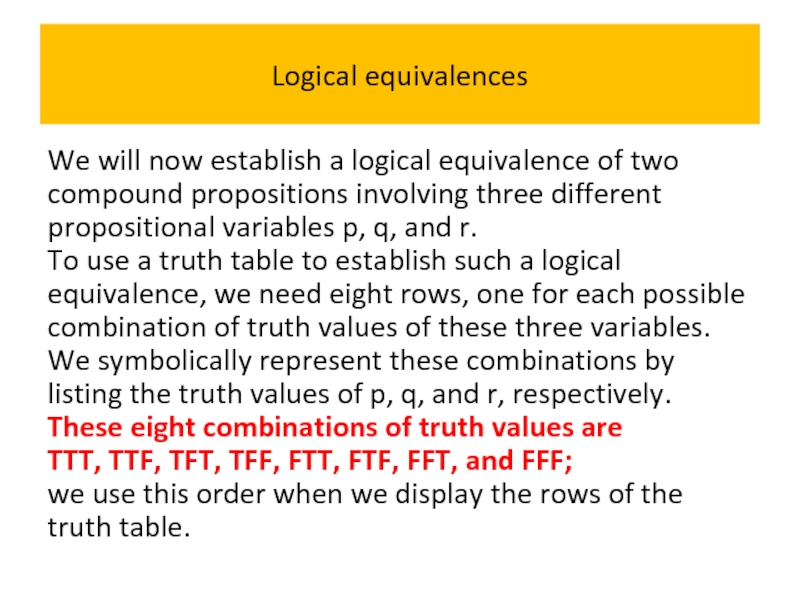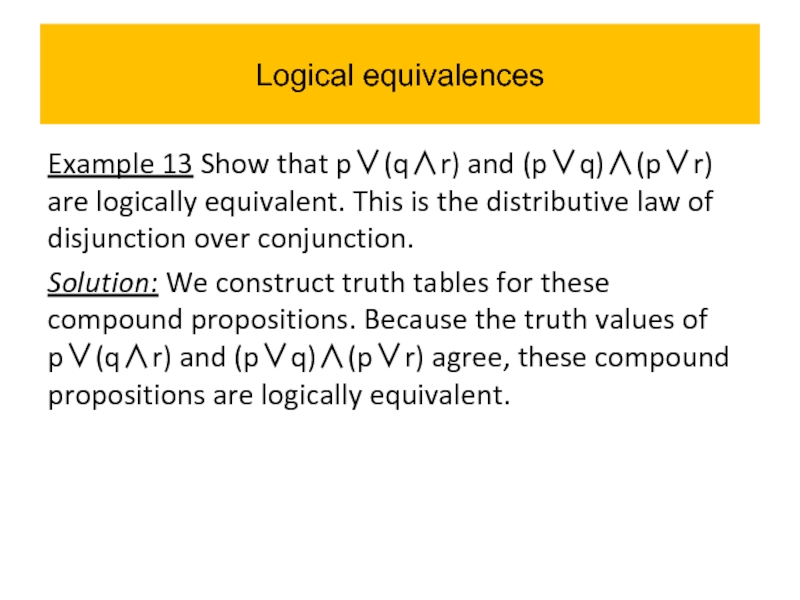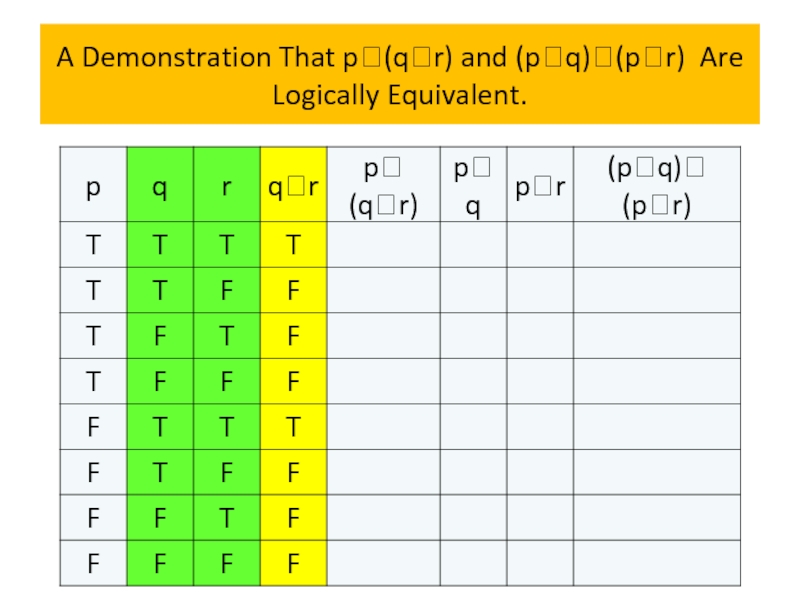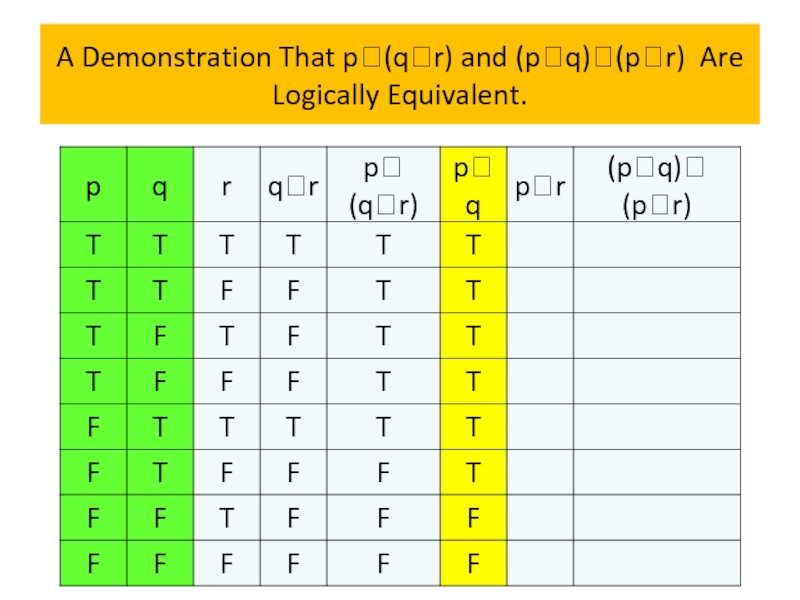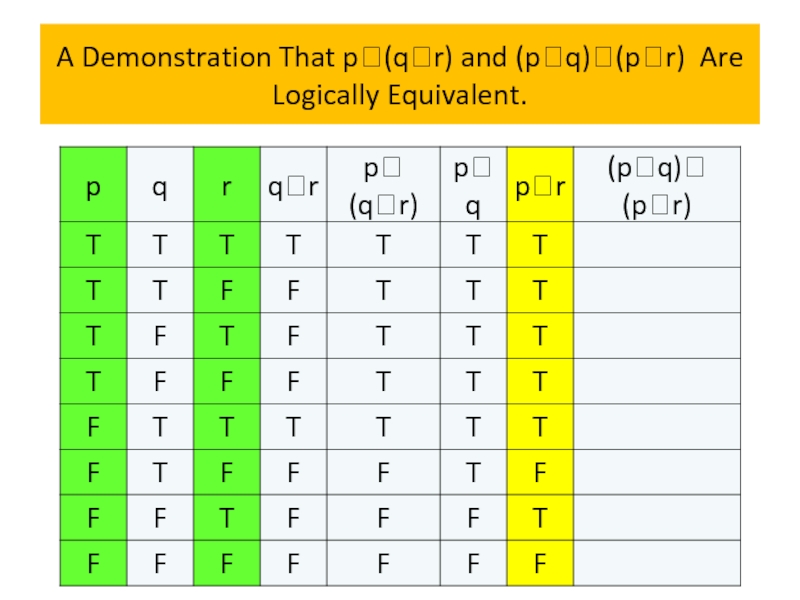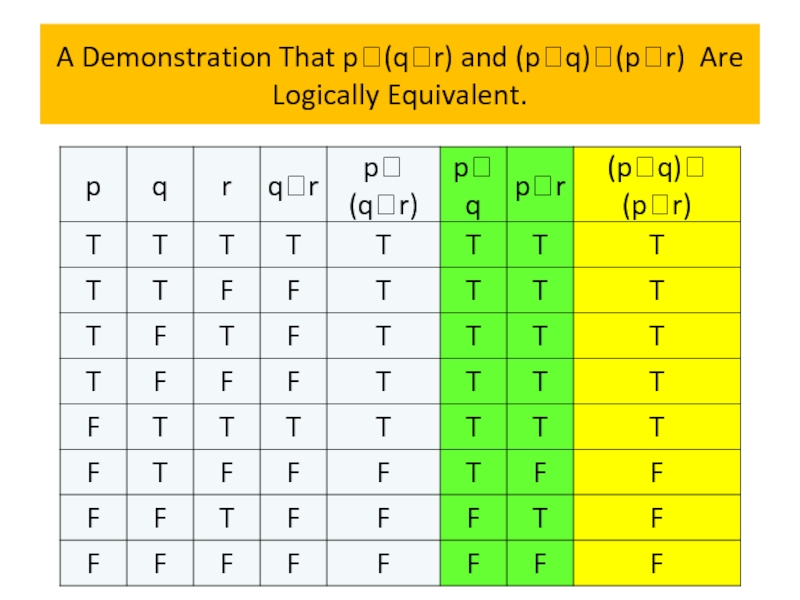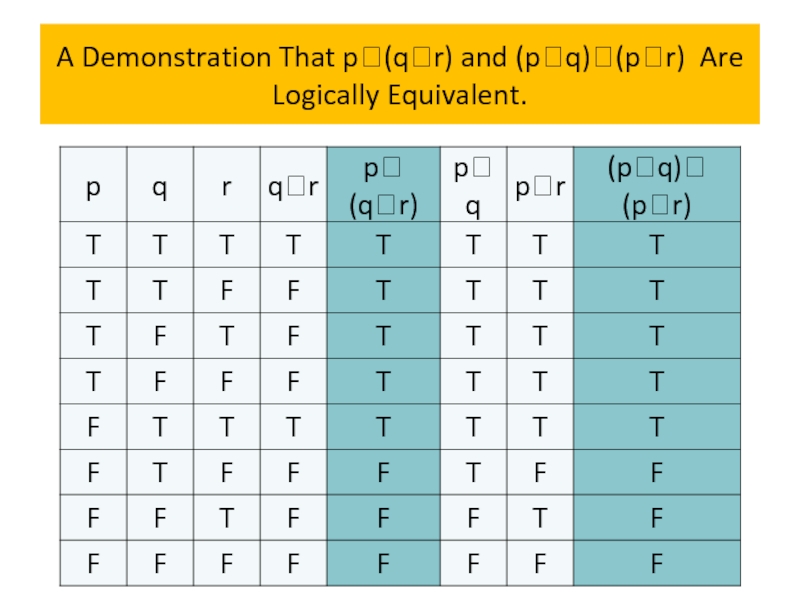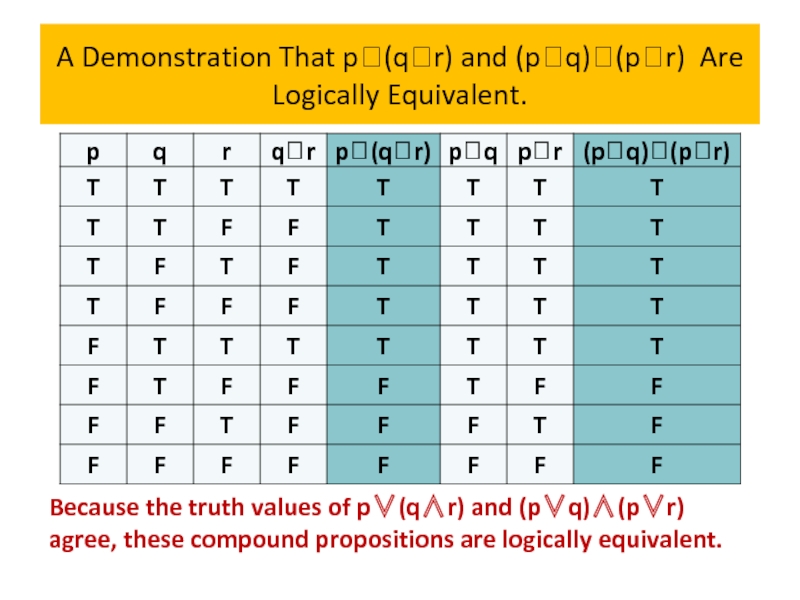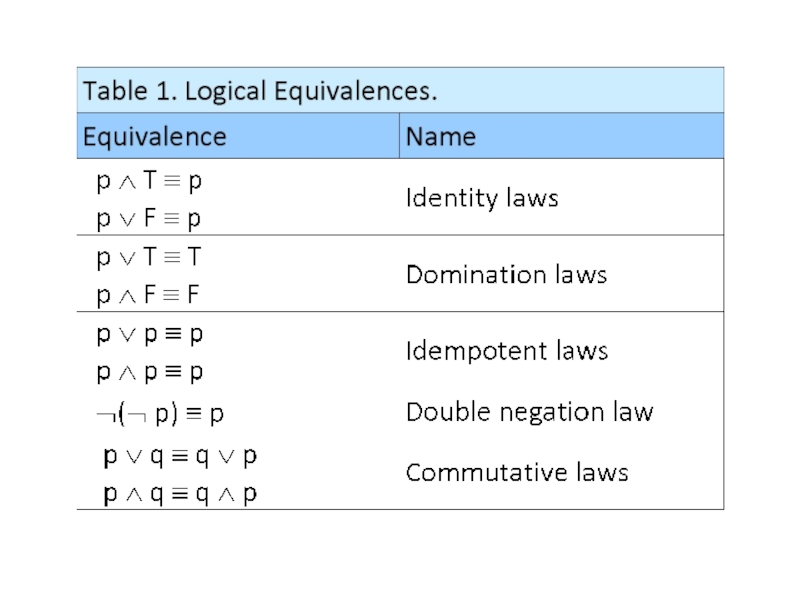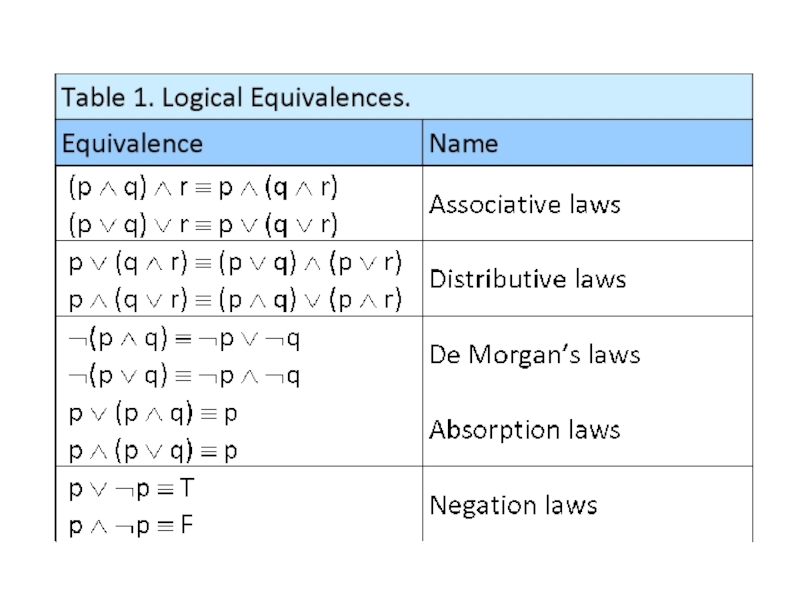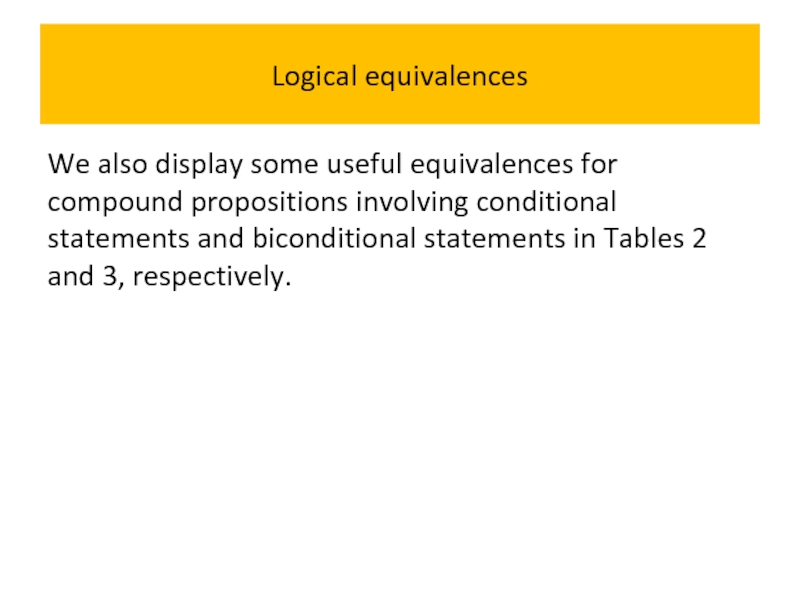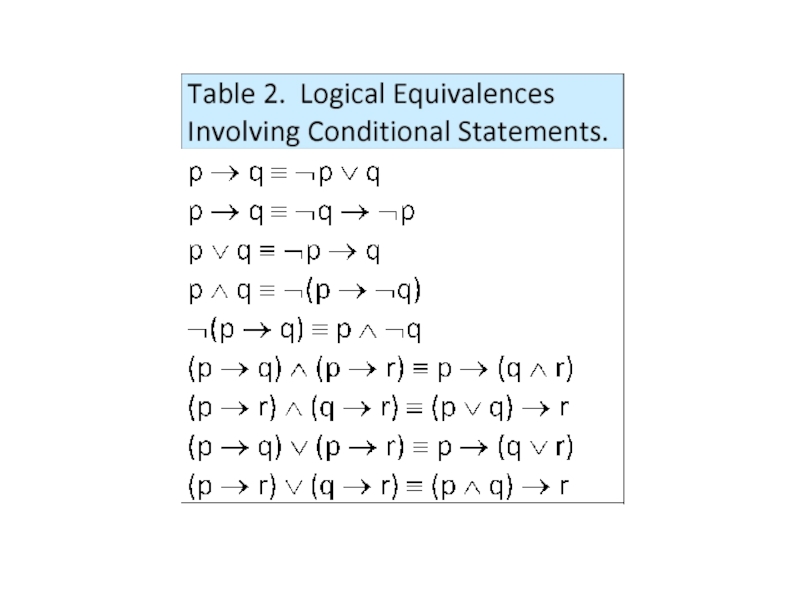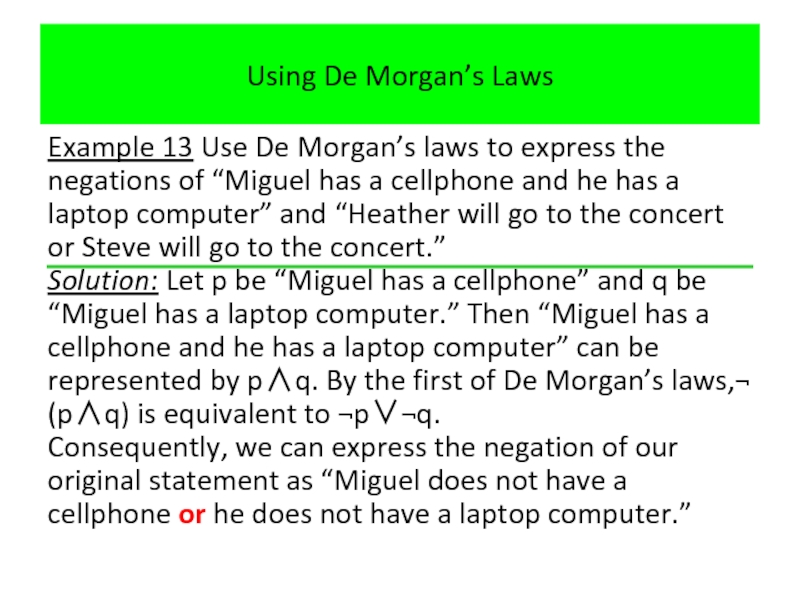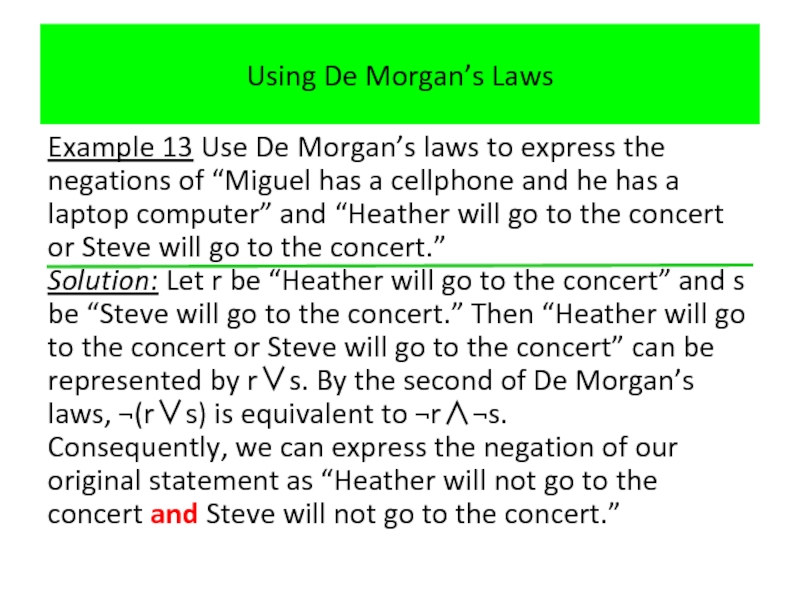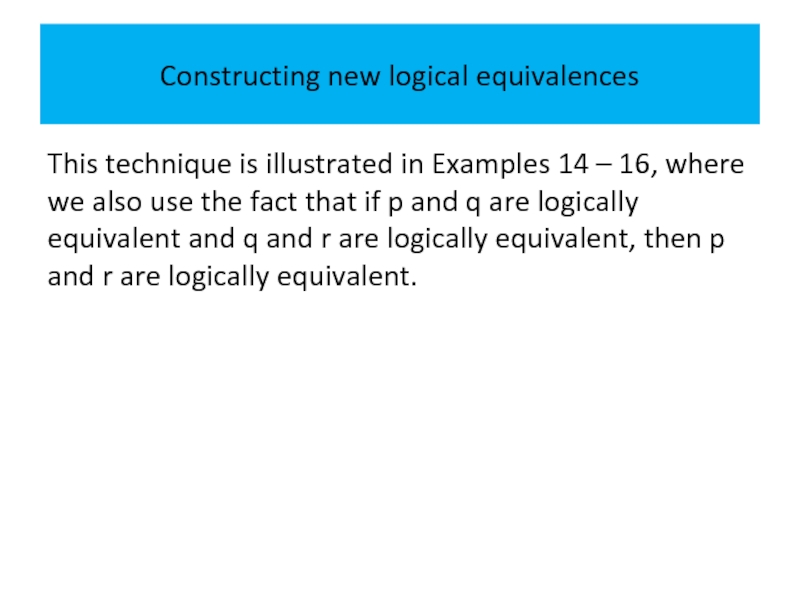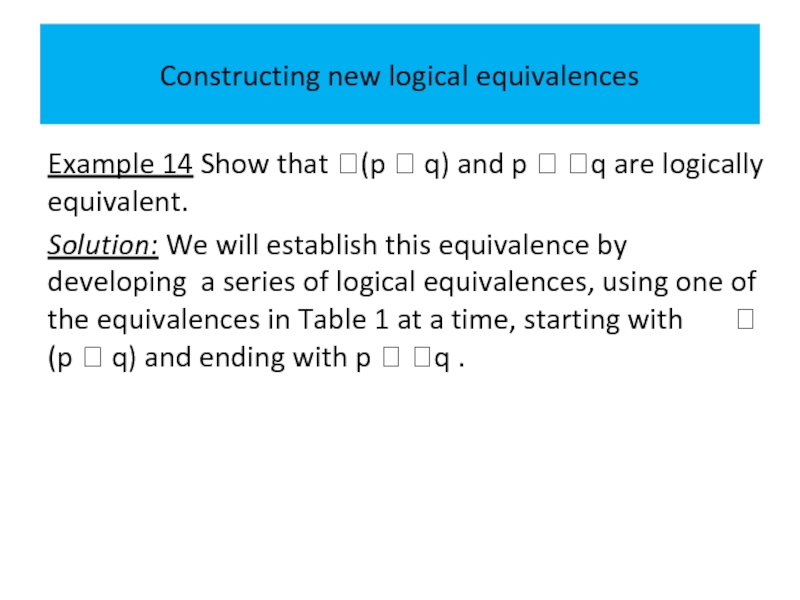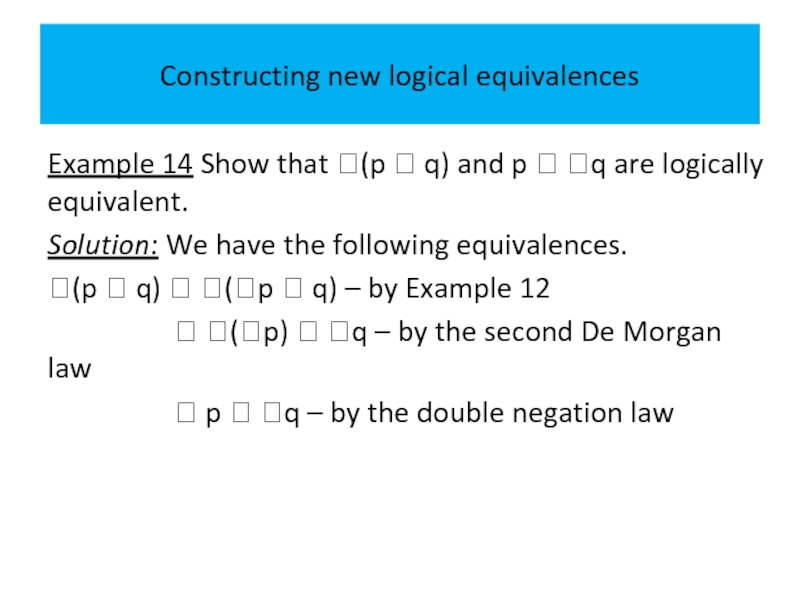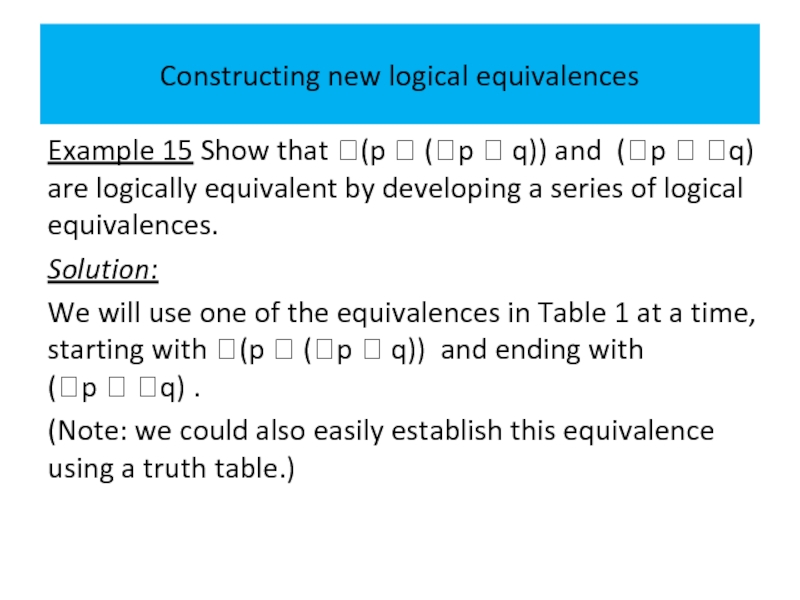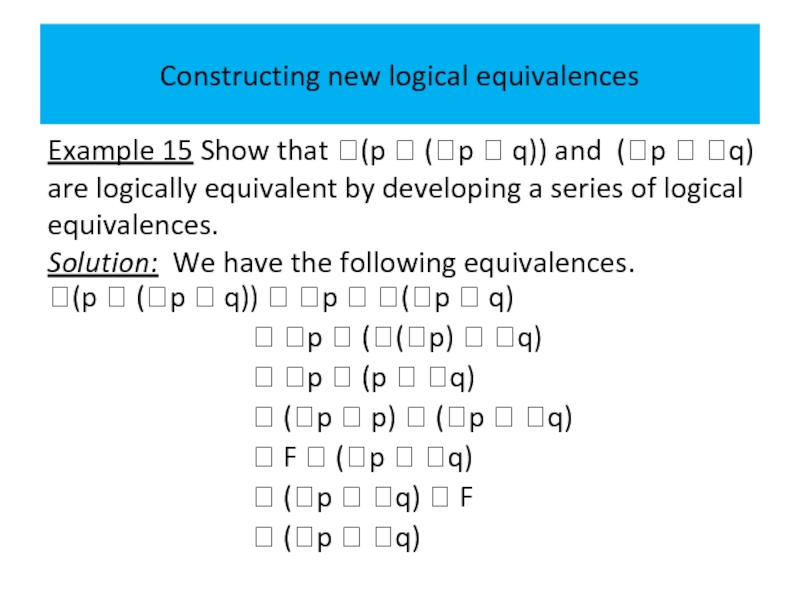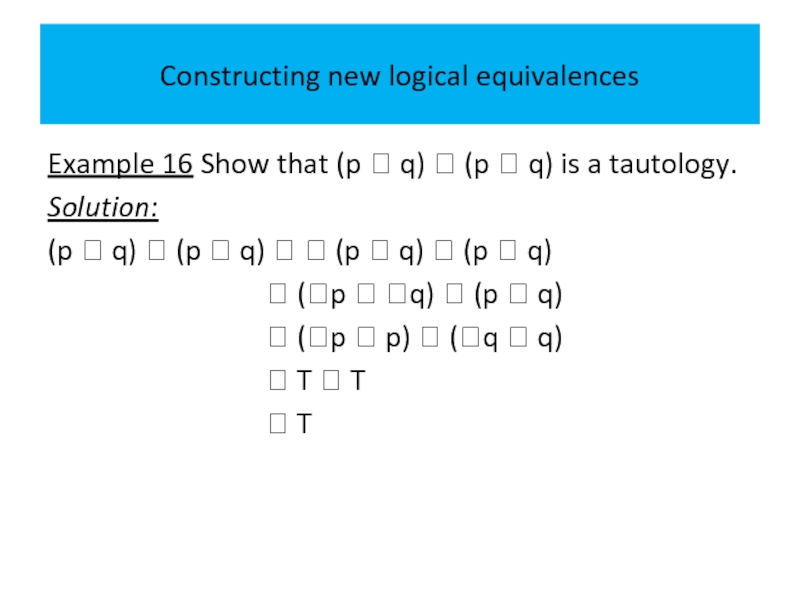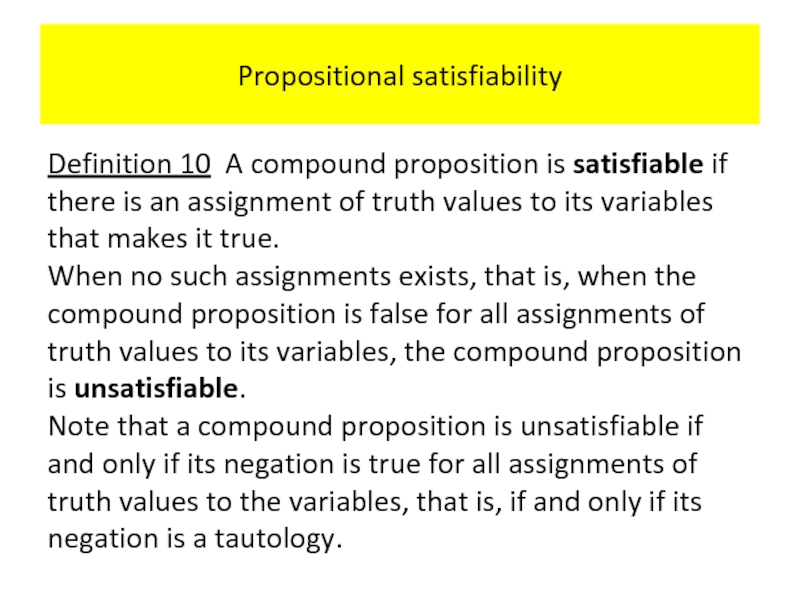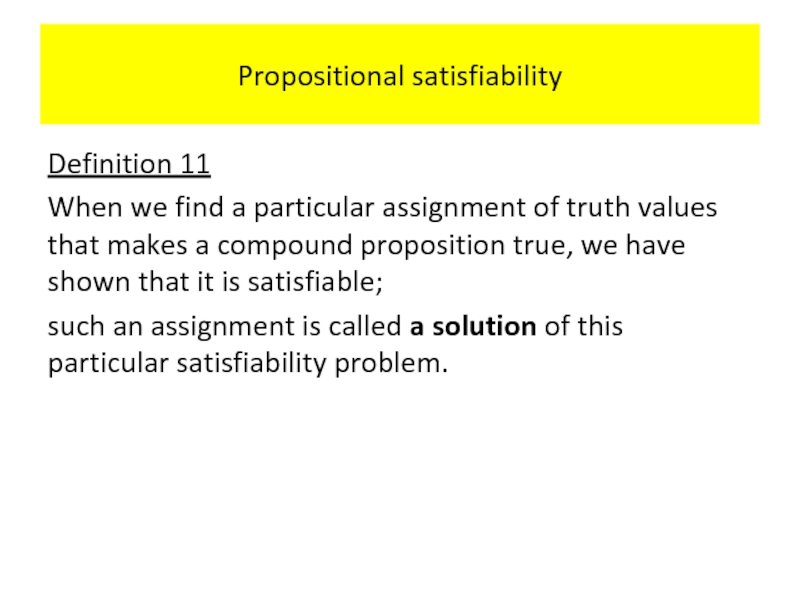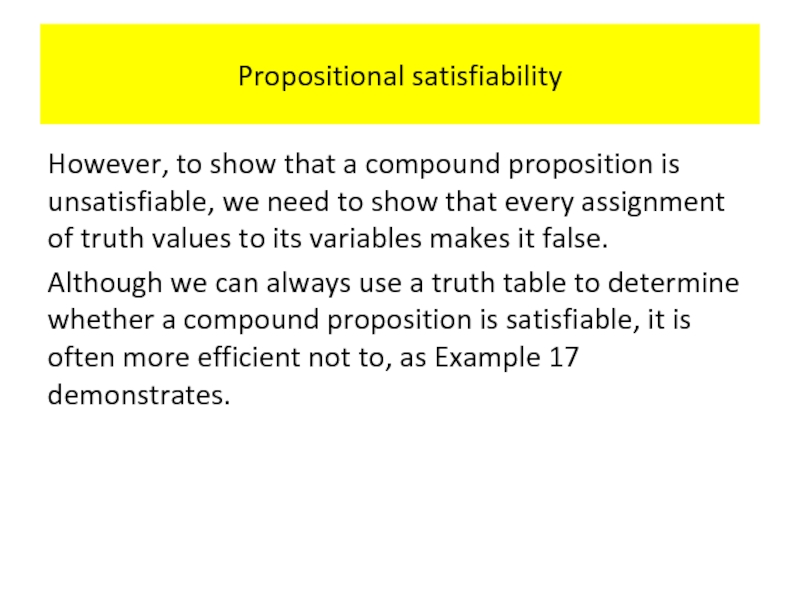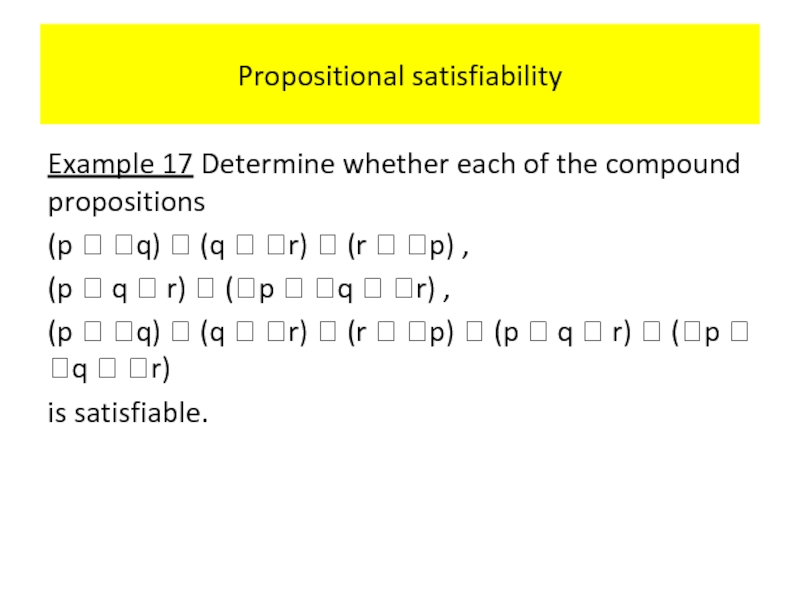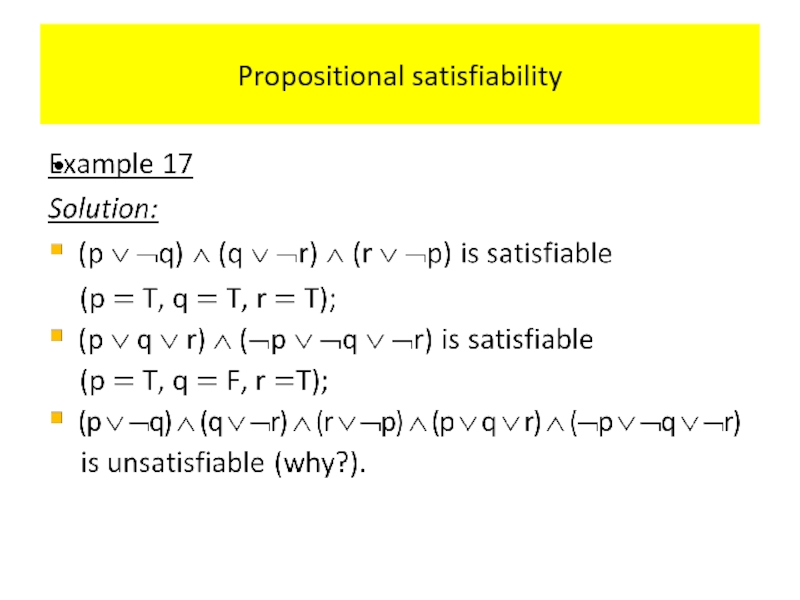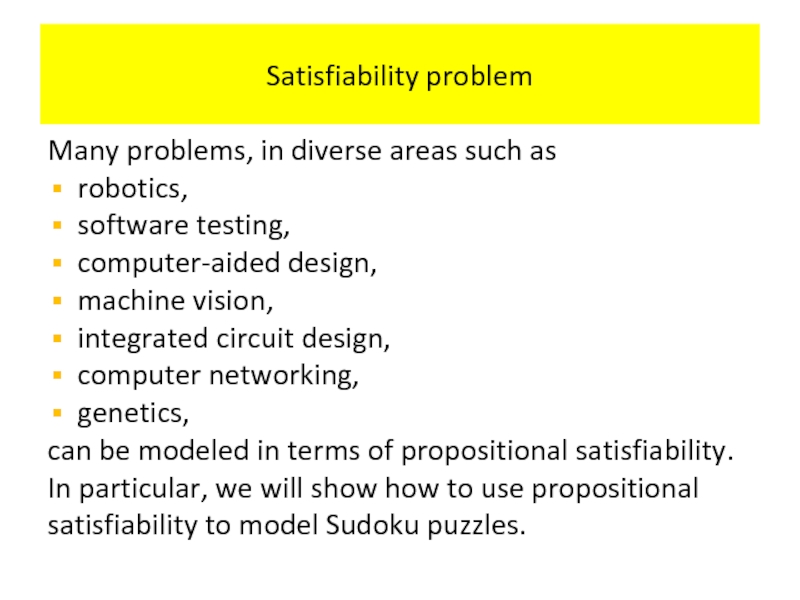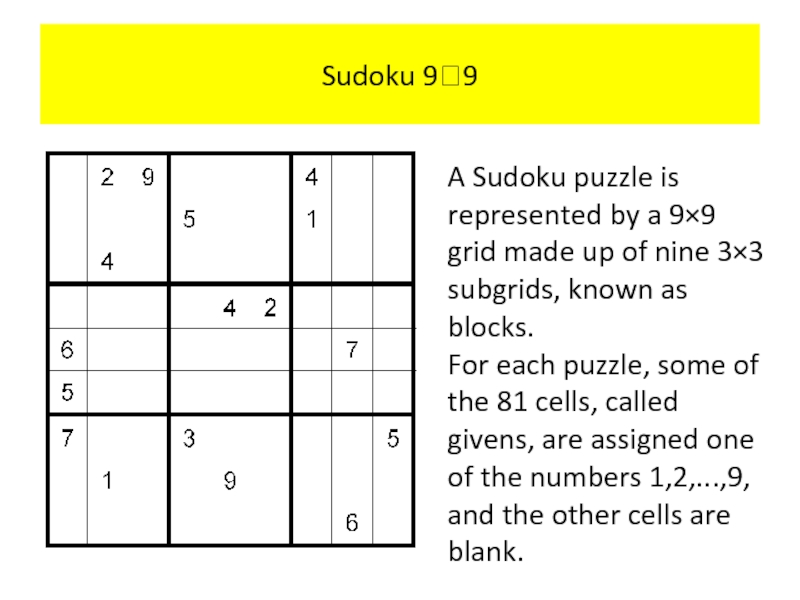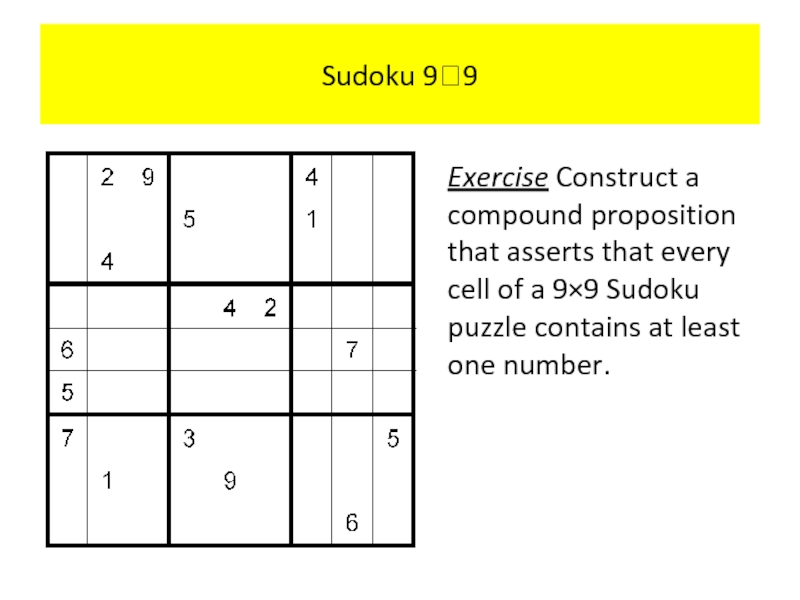- Главная
- Разное
- Дизайн
- Бизнес и предпринимательство
- Аналитика
- Образование
- Развлечения
- Красота и здоровье
- Финансы
- Государство
- Путешествия
- Спорт
- Недвижимость
- Армия
- Графика
- Культурология
- Еда и кулинария
- Лингвистика
- Английский язык
- Астрономия
- Алгебра
- Биология
- География
- Детские презентации
- Информатика
- История
- Литература
- Маркетинг
- Математика
- Медицина
- Менеджмент
- Музыка
- МХК
- Немецкий язык
- ОБЖ
- Обществознание
- Окружающий мир
- Педагогика
- Русский язык
- Технология
- Физика
- Философия
- Химия
- Шаблоны, картинки для презентаций
- Экология
- Экономика
- Юриспруденция
Propositional logic презентация
Содержание
- 1. Propositional logic
- 2. Propositions Our discussion begins with an introduction
- 3. Propositions Example 1 All the following
- 4. Propositions
- 5. Propositions
- 6. Propositions The area of logic that deals
- 7. Compound propositions We now turn our attention
- 8. Compound propositions Many mathematical statements are constructed
- 9. The negation of a proposition
- 10. The negation of a proposition
- 11. The negation of a proposition Example 3
- 12. The conjunction of two propositions Definition 3
- 13. The conjunction of two propositions
- 14. The conjunction of two propositions Example 4
- 15. The conjunction of two propositions
- 16. The disjunction of two propositions Definition 4
- 17. The disjunction of two propositions
- 18. The disjunction of two propositions Example 5
- 19. The disjunction of two propositions
- 20. The exclusive or The use of
- 21. The exclusive or On the other
- 22. The exclusive or Definition 5
- 23. The exclusive or
- 24. Conditional statements
- 25. Conditional statements
- 26. Conditional statements
- 27. Conditional statements
- 28. Conditional statements
- 29. Converse, contrapositive and inverse
- 30. Converse, contrapositive and inverse
- 31. Biconditionals
- 32. Biconditionals
- 33. Biconditionals
- 34. Biconditionals
- 35. Truth tables of compound propositions We have
- 36. Truth tables of compound propositions We can
- 37. Truth tables of compound propositions Example 9
- 38. Truth tables of compound propositions Example 9
- 39. Truth tables of compound propositions Example 9
- 40. Truth tables of compound propositions Example 9
- 41. Truth tables of compound propositions Example 9
- 42. Truth tables of compound propositions Example 9
- 43. Truth tables of compound propositions Example 9
- 44. Precedence of logical operators
- 45. Precedence of logical operators
- 46. Precedence of logical operators
- 47. Precedence of logical operators Another general rule
- 48. Precedence of logical operators
- 49. Tautologies and contradictions Definition 8 A compound
- 50. Tautologies and contradictions Example 10 We can
- 51. Tautologies and contradictions
- 52. Logical equivalences
- 53. Logical equivalences One way to determine whether
- 54. Logical equivalences Example 11 Show that (pq) and pq are logically equivalent.
- 55. Logical equivalences Example 11 Show that (pq) and pq are logically equivalent.
- 56. Logical equivalences Example 11 Show that (pq) and pq are logically equivalent.
- 57. Logical equivalences Example 11 Show that (pq) and pq are logically equivalent.
- 58. Logical equivalences Example 11 Show that (pq) and pq are logically equivalent.
- 59. Logical equivalences Example 2 Show that (pq) and pq are logically equivalent.
- 60. Logical equivalences Example 11 Show that (pq) and pq are logically equivalent.
- 61. Logical equivalences
- 62. Logical equivalences (pq) pq
- 63. Logical equivalences
- 64. Logical equivalences
- 65. Logical equivalences
- 66. Logical equivalences
- 67. Logical equivalences
- 68. Logical equivalences
- 69. Logical equivalences
- 70. Logical equivalences We will now establish a
- 71. Logical equivalences Example 13 Show that p∨(q∧r)
- 72. A Demonstration That p(qr) and (pq)(pr) Are Logically Equivalent.
- 73. A Demonstration That p(qr) and (pq)(pr) Are Logically Equivalent.
- 74. A Demonstration That p(qr) and (pq)(pr) Are Logically Equivalent.
- 75. A Demonstration That p(qr) and (pq)(pr) Are Logically Equivalent.
- 76. A Demonstration That p(qr) and (pq)(pr) Are Logically Equivalent.
- 77. A Demonstration That p(qr) and (pq)(pr) Are Logically Equivalent.
- 78. A Demonstration That p(qr) and (pq)(pr) Are Logically Equivalent.
- 79. A Demonstration That p(qr) and (pq)(pr) Are
- 80. Logical equivalences Next table contains some important
- 83. Logical equivalences
- 84. Logical equivalences We also display some useful
- 87. Using De Morgan’s Laws Example 13 Use
- 88. Using De Morgan’s Laws Example 13 Use
- 89. Constructing new logical equivalences The logical equivalences
- 90. Constructing new logical equivalences This technique is
- 91. Constructing new logical equivalences Example 14 Show
- 92. Constructing new logical equivalences Example 14 Show
- 93. Constructing new logical equivalences Example 15 Show
- 94. Constructing new logical equivalences Example 15 Show
- 95. Constructing new logical equivalences Example 16 Show
- 96. Propositional satisfiability Definition 10 A compound proposition
- 97. Propositional satisfiability Definition 11 When we
- 98. Propositional satisfiability However, to show that a
- 99. Propositional satisfiability Example 17 Determine whether each
- 100. Propositional satisfiability
- 101. Satisfiability problem Many problems, in diverse areas
- 102. Sudoku 99 A Sudoku puzzle is represented
- 103. Sudoku 99 The puzzle is solved by
- 104. Sudoku 99 Exercise Construct a compound proposition
Слайд 1Propositional logic
Irina Prosvirnina
Propositions
Compound
Conditional statements
Truth tables of compound propositions
Tautologies and contradictions
Logical equivalences
Propositional satisfiability
Satisfiability problem
Слайд 2Propositions
Our discussion begins with an introduction to the basic building blocks
Definition 1
A proposition is a declarative sentence (that is, a sentence that declares a fact) that is either true or false, but not both.
Слайд 3Propositions
Example 1
All the following declarative sentences are propositions.
1. Minsk is
2. Toronto is the capital of Canada.
3. 1+1=2.
4. 2+2=3.
Propositions 1 and 3 are true, whereas 2 and 4 are false.
Слайд 6Propositions
The area of logic that deals with propositions is called the
It was first developed systematically by the Greek philosopher Aristotle more than 2300 years ago.
Aristotle
(384 b.c.e.–322 b.c.e.)
Слайд 7Compound propositions
We now turn our attention to methods for producing new
These methods were discussed by the English mathematician George Boole in 1854 in his book The Laws of Thought.
George Boole
(1815–1864)
Слайд 8Compound propositions
Many mathematical statements are constructed by combining one or more
New propositions, called compound propositions, are formed from existing propositions using logical operators.
Слайд 11The negation of a proposition
Example 3 Find the negation of the
Solution The negation is “It is not the case that Vandana’s smartphone has at least 32GB of memory.”
This negation can also be expressed as “Vandana’s smartphone does not have at least 32GB of memory” or even more simply as “Vandana’s smartphone has less than 32GB of memory.”
Слайд 12The conjunction of two propositions
Definition 3
Let p and q be
Слайд 14The conjunction of two propositions
Example 4 Find the conjunction of the
Слайд 15The conjunction of two propositions
Solution The conjunction of these propositions, p∧q,
This conjunction can be expressed more simply as “Rebecca’s PC has more than 16 GB free hard disk space, and its processor runs faster than 1 GHz.”
For this conjunction to be true, both conditions given must be true. It is false, when one or both of these conditions are false.
Find the conjunction of the propositions p and q where p is the proposition “Rebecca’s PC has more than 16 GB free hard disk space” and q is the proposition “The processor in Rebecca’s PC runs faster than 1 GHz.”
Слайд 16The disjunction of two propositions
Definition 4
Let p and q be
Слайд 18The disjunction of two propositions
Example 5 Find the disjunction of the
Слайд 19The disjunction of two propositions
Solution The disjunction of p and q,
This proposition is true when Rebecca’s PC has at least 16 GB free hard disk space, when the PC’s processor runs faster than 1 GHz, and when both conditions are true. It is false when both of these conditions are false, that is, when Rebecca’s PC has less than 16 GB free hard disk space and the processor in her PC runs at 1 GHz or slower.
Find the disjunction of the propositions p and q where p is the proposition “Rebecca’s PC has more than 16 GB free hard disk space” and q is the proposition “The processor in Rebecca’s PC runs faster than 1 GHz.”
Слайд 20The exclusive or
The use of the connective or in a
A disjunction is true when at least one of the two propositions is true.
Слайд 21The exclusive or
On the other hand, we are using the
Here, we mean that students who have taken both calculus and a computer science course cannot take the class. Only those who have taken exactly one of the two courses can take the class.
Слайд 22The exclusive or
Definition 5
Let p and q be propositions.
Слайд 35Truth tables of compound propositions
We have now introduced four important logical
We can use these connectives to build up complicated compound propositions involving any number of propositional variables.
Слайд 36Truth tables of compound propositions
We can use truth tables to determine
We use a separate column to find the truth value of each compound expression that occurs in the compound proposition as it is built up.
The truth values of the compound proposition for each combination of truth values of the propositional variables in it is found in the final column of the table.
Слайд 37Truth tables of compound propositions
Example 9 Construct the truth table of
Solution
Because this truth table involves two propositional variables p and q, there are four rows in this truth table, one for each of the pairs of truth values TT, TF, FT, and FF.
Слайд 38Truth tables of compound propositions
Example 9 Construct the truth table of
Solution
The first two columns are used for the truth values of p and q, respectively. In the third column we find the truth value of q, needed to find the truth value of pq, found in the fourth column.
The fifth column gives the truth value of pq.
Finally, the truth value of (pq) (pq) is found in the last column.
Слайд 39Truth tables of compound propositions
Example 9 Construct the truth table of
Слайд 40Truth tables of compound propositions
Example 9 Construct the truth table of
Слайд 41Truth tables of compound propositions
Example 9 Construct the truth table of
Слайд 42Truth tables of compound propositions
Example 9 Construct the truth table of
Слайд 43Truth tables of compound propositions
Example 9 Construct the truth table of
Слайд 47Precedence of logical operators
Another general rule of precedence is that the
Слайд 49Tautologies and contradictions
Definition 8
A compound proposition that is always true, no
A compound proposition that is always false is called a contradiction.
A compound proposition that is neither a tautology nor a contradiction is called a contingency.
Слайд 50Tautologies and contradictions
Example 10
We can construct examples of tautologies and contradictions
Слайд 53Logical equivalences
One way to determine whether two compound propositions are equivalent
In particular, the compound propositions p and q are equivalent if and only if the columns giving their truth values agree.
Слайд 62Logical equivalences
(pq) pq
This logical equivalence is one of the
Augustus de Morgan
(1806–1871)
Слайд 70Logical equivalences
We will now establish a logical equivalence of two compound
To use a truth table to establish such a logical equivalence, we need eight rows, one for each possible combination of truth values of these three variables. We symbolically represent these combinations by listing the truth values of p, q, and r, respectively.
These eight combinations of truth values are
TTT, TTF, TFT, TFF, FTT, FTF, FFT, and FFF;
we use this order when we display the rows of the truth table.
Слайд 71Logical equivalences
Example 13 Show that p∨(q∧r) and (p∨q)∧(p∨r) are logically equivalent.
Solution: We construct truth tables for these compound propositions. Because the truth values of p∨(q∧r) and (p∨q)∧(p∨r) agree, these compound propositions are logically equivalent.
Слайд 79A Demonstration That p(qr) and (pq)(pr) Are Logically Equivalent.
Because the
Слайд 80Logical equivalences
Next table contains some important equivalences.
In these equivalences, T
Слайд 84Logical equivalences
We also display some useful equivalences for compound propositions involving
Слайд 87Using De Morgan’s Laws
Example 13 Use De Morgan’s laws to express
Solution: Let p be “Miguel has a cellphone” and q be “Miguel has a laptop computer.” Then “Miguel has a cellphone and he has a laptop computer” can be represented by p∧q. By the first of De Morgan’s laws,¬(p∧q) is equivalent to ¬p∨¬q.
Consequently, we can express the negation of our original statement as “Miguel does not have a cellphone or he does not have a laptop computer.”
Слайд 88Using De Morgan’s Laws
Example 13 Use De Morgan’s laws to express
Solution: Let r be “Heather will go to the concert” and s be “Steve will go to the concert.” Then “Heather will go to the concert or Steve will go to the concert” can be represented by r∨s. By the second of De Morgan’s laws, ¬(r∨s) is equivalent to ¬r∧¬s.
Consequently, we can express the negation of our original statement as “Heather will not go to the concert and Steve will not go to the concert.”
Слайд 89Constructing new logical equivalences
The logical equivalences in Table 1, as well
The reason for this is that a proposition in a compound proposition can be replaced by a compound proposition that is logically equivalent to it without changing the truth value of the original compound proposition.
Слайд 90Constructing new logical equivalences
This technique is illustrated in Examples 14 –
Слайд 91Constructing new logical equivalences
Example 14 Show that (p q) and
Solution: We will establish this equivalence by developing a series of logical equivalences, using one of the equivalences in Table 1 at a time, starting with (p q) and ending with p q .
Слайд 92Constructing new logical equivalences
Example 14 Show that (p q) and
Solution: We have the following equivalences.
(p q) (p q) – by Example 12
(p) q – by the second De Morgan law
p q – by the double negation law
Слайд 93Constructing new logical equivalences
Example 15 Show that (p (p
Solution:
We will use one of the equivalences in Table 1 at a time, starting with (p (p q)) and ending with (p q) .
(Note: we could also easily establish this equivalence using a truth table.)
Слайд 94Constructing new logical equivalences
Example 15 Show that (p (p
Solution: We have the following equivalences.
(p (p q)) p (p q)
p ((p) q)
p (p q)
(p p) (p q)
F (p q)
(p q) F
(p q)
Слайд 95Constructing new logical equivalences
Example 16 Show that (p q)
Solution:
(p q) (p q) (p q) (p q)
(p q) (p q)
(p p) (q q)
T T
T
Слайд 96Propositional satisfiability
Definition 10 A compound proposition is satisfiable if there is
When no such assignments exists, that is, when the compound proposition is false for all assignments of truth values to its variables, the compound proposition is unsatisfiable.
Note that a compound proposition is unsatisfiable if and only if its negation is true for all assignments of truth values to the variables, that is, if and only if its negation is a tautology.
Слайд 97Propositional satisfiability
Definition 11
When we find a particular assignment of truth
such an assignment is called a solution of this particular satisfiability problem.
Слайд 98Propositional satisfiability
However, to show that a compound proposition is unsatisfiable, we
Although we can always use a truth table to determine whether a compound proposition is satisfiable, it is often more efficient not to, as Example 17 demonstrates.
Слайд 99Propositional satisfiability
Example 17 Determine whether each of the compound propositions
(p
(p q r) (p q r) ,
(p q) (q r) (r p) (p q r) (p q r)
is satisfiable.
Слайд 101Satisfiability problem
Many problems, in diverse areas such as
robotics,
software testing,
computer-aided design,
machine vision,
integrated circuit design,
computer networking,
genetics,
can be modeled in terms of propositional satisfiability.
In particular, we will show how to use propositional satisfiability to model Sudoku puzzles.
Слайд 102Sudoku 99
A Sudoku puzzle is represented by a 9×9 grid made
For each puzzle, some of the 81 cells, called givens, are assigned one of the numbers 1,2,...,9, and the other cells are blank.
